Interesting
Revised 12/16/25 added one image to YMCA Promotions
In dealing with any topic there is always the agonizing question of what to include and what to exclude. Let’s look at some items in this fuzzy area.
Topic 1: Are They or Aren’t They (Nude)?
The following pictures were excluded because of the ambiguity of their subject matter.
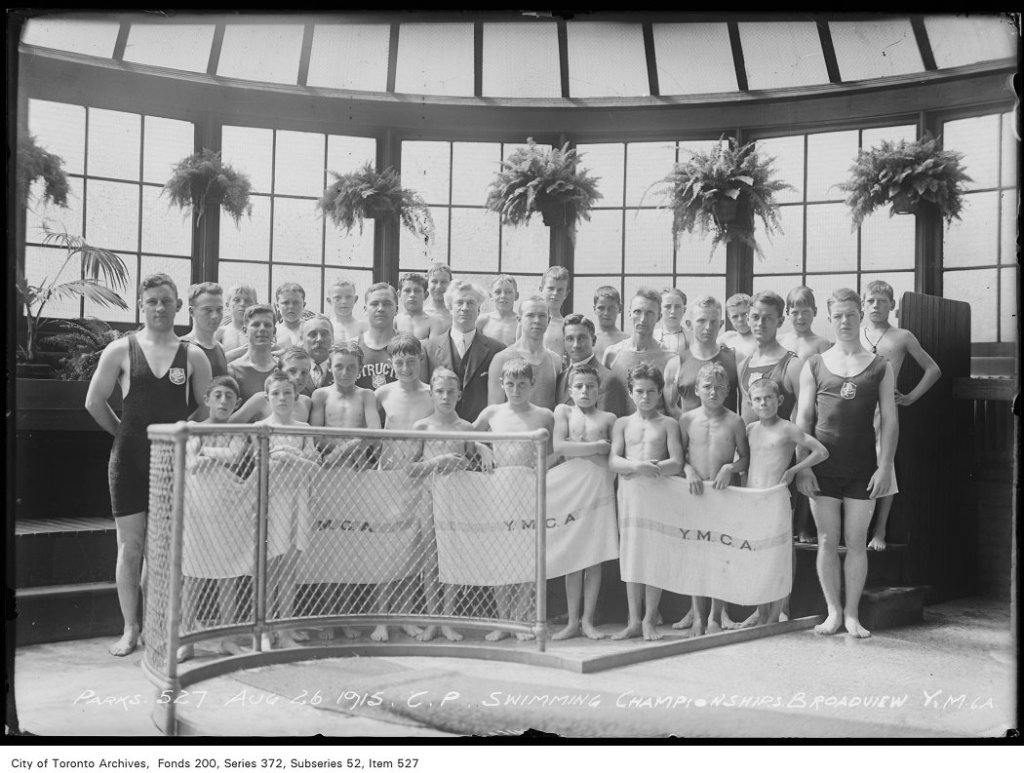
The edge label and ink inscription identify this group as the YMCA swimming champs of 1915 Toronto. So why are the smaller guys down in front holding towels up to their mid sections? Because they’re naked, right?
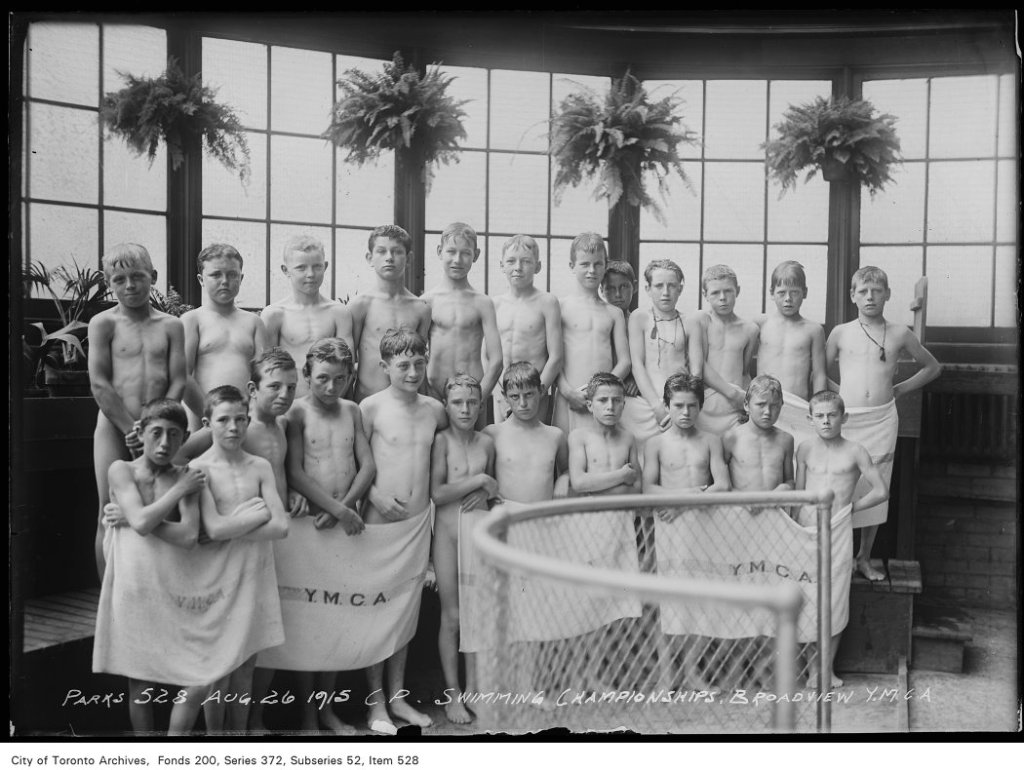
An awkward shot by any standard, but it’s clear the guys on the upper left are resorting to hiding behind their hands. Yeah, they’re nude.
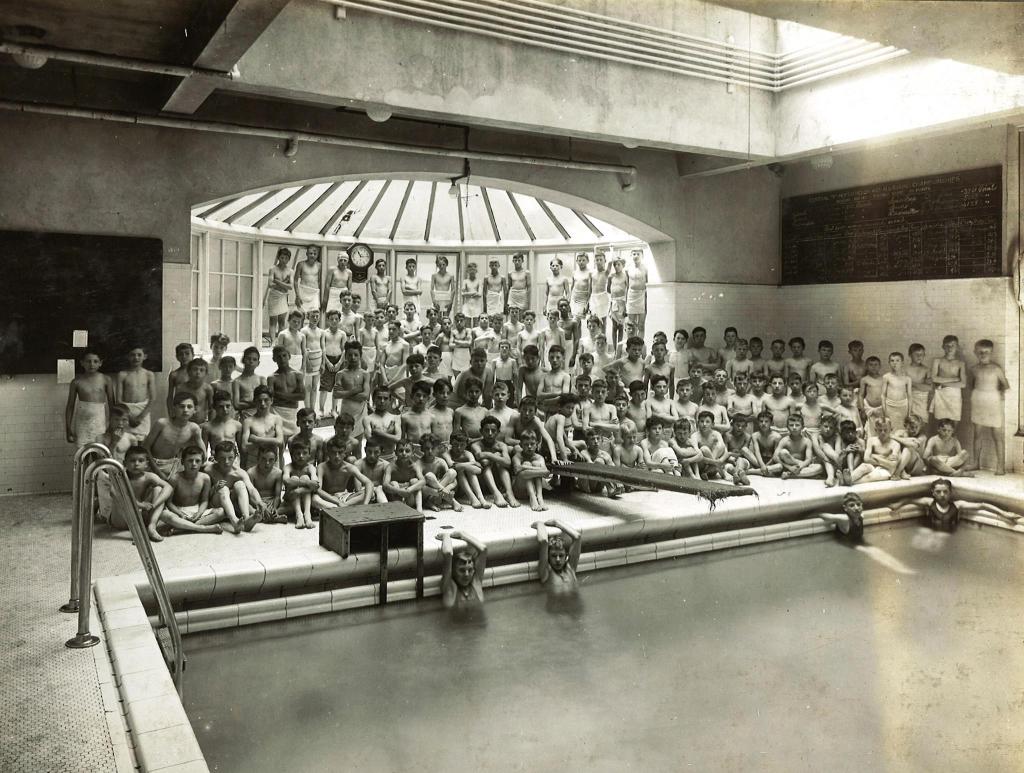
We’re back at the Broadview YMCA, but time has moved on. In this undated photo, the hanging plants in the glassed atrium have disappeared along with the chain link barrier. A wall clock has been added as has a single racing starting block. Most remarkable, a wall containing and archway has intervened between the pool and the atrium. (See the photo Swimming in the Dark in Not So Special Topics for comparison.)
The practice of nude swimming continues, however. This large class of mostly nude student swimmers has donned the customary towels for the camera. The game with this sort of image is to detect any boys who have been lax in their modesty. This requires aggressive zooming.
The two boys on either side of the diving board are in that sort of pose, but their masculinity is not apparent. A correspondent using more sophisticated techniques advises that the picture has been altered (effecting a photographic castration) and that traces of the process can be detected. I was not able to fully duplicate his results. However, I think I made my own discovery. Check out the boy just off the right rear corner of the starting block. I see an elongated white line in about the right spot. Is he a tattle tale?
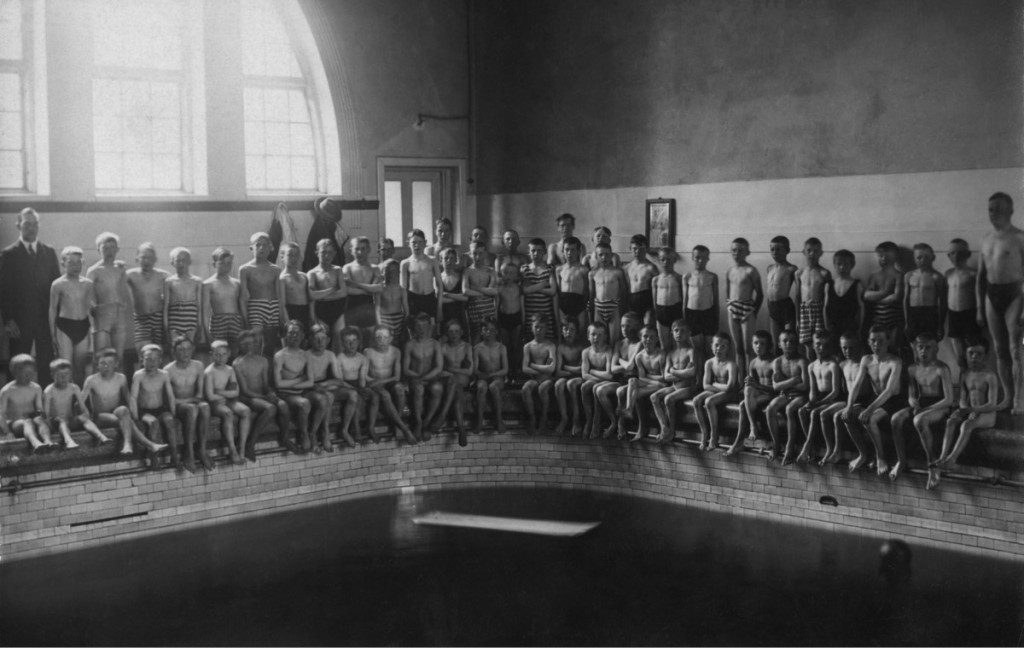
In a markedly similar scene, the denizens of this Swedish “hot bath house” (indoor pool) posed for a group shot. The date is between 1920 and 1930 and is archived by the Sundsvalls Museum by way of the Digital Museum service.
All of the standing figures are suited, but the seated boys are a different matter. Some look like they are in suits, but there is no denying the bare haunch on the right side of the line.
Moving to another part of Canada, it seems that the denizens of Montreal had their own take on the camera towel dance. These three undated images are from the YMCA of Montreal.

It looks as though the photographer asked the assembled men to either put on towels or turn their backs. It looks like there are at least four non-compliant nudes in this shot. However, it is the group of well-dressed men occupying the upper walkway that garners attention. They appear to be wearing high collars and a few have bushy mustaches. That might indicate that this photo dates to the 1890-1910 period. As with all such shots, there is a curious anomaly: Is that an old woman on the far right of the walkway leaning over and peering at the activity in the pool?
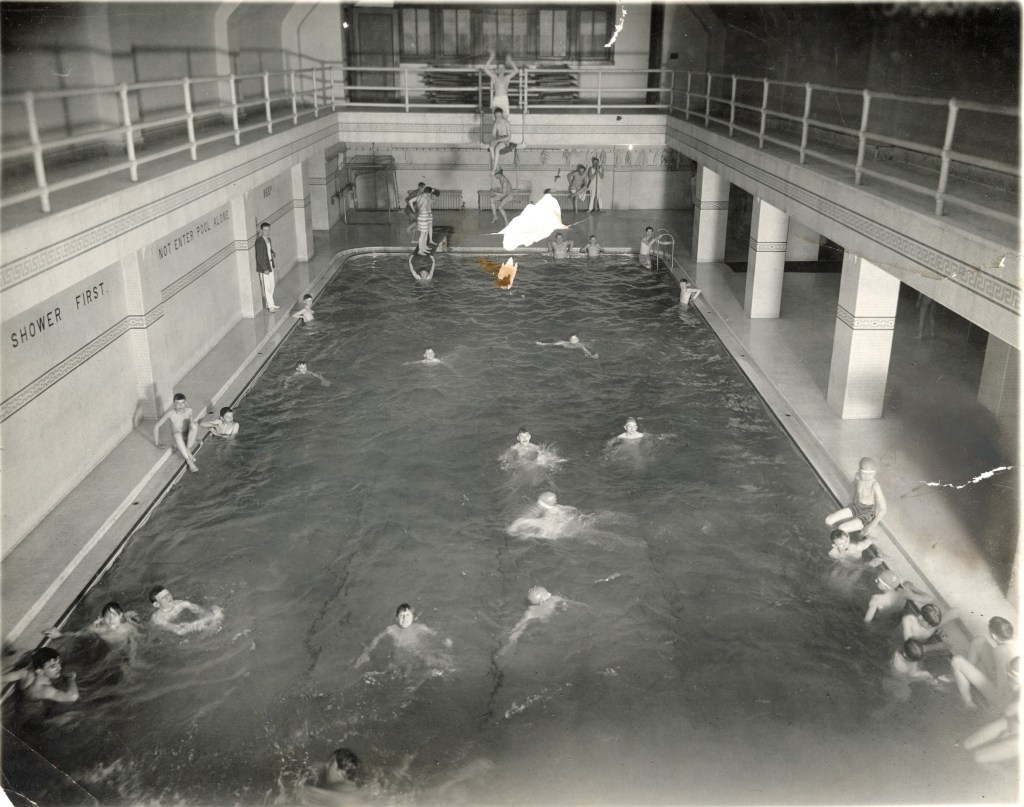
This photo captures the activity in the same venue as the pervious image but on another occasion when the participants are boys. Although this image sustained significant damage, the photo records some unusual features. Many of the boys who are in trunks are also wearing bathing caps. The other places we saw caps were in the The Good posting one of which showed a Jewish youth group from around 1920 and the other a group of Black swimmers in the Brooklyn YMCA in 1939. However, in those photos, the boys eschewed bathing suits. Finally, take note of the only unambiguous nude on the trapeze in the top center of the frame.

This image is likely more recent than the previous two. The high waists of the trunks on the two instructors suggests 1940s or so. Their charges are probably not so encumbered. The subsurface appearance of the boy on the lower right of the image indicates a lack of a suit. The more definitive evidence is probably the boy in the upper right whose lunge exposes a flank that is bare to the buttock.
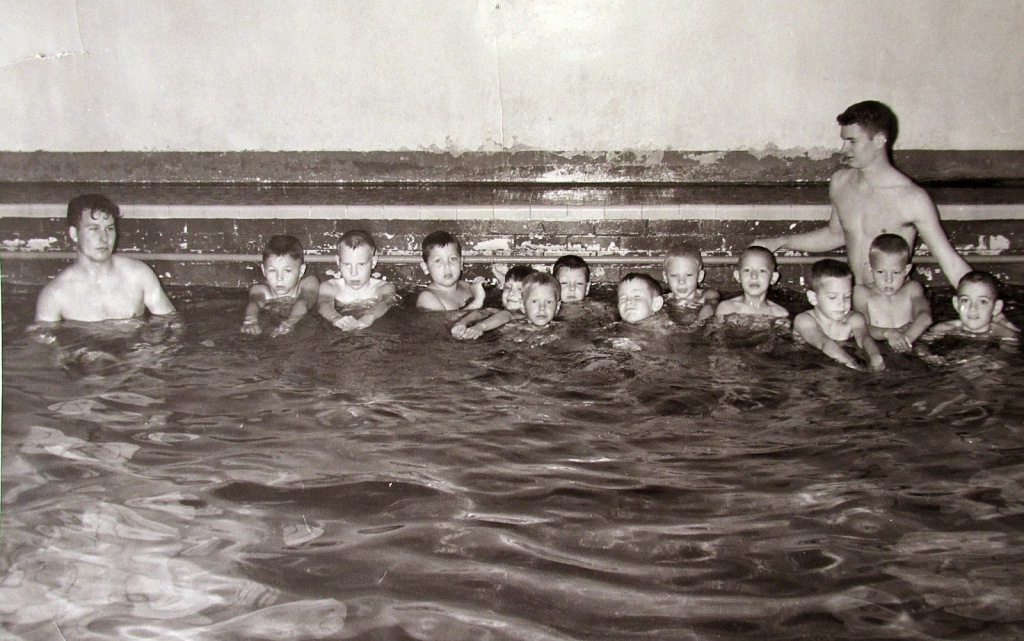
In a somewhat later era, we have a youngsters’ swim class in Walla Walla, Washington overseen by a couple of teenagers with everyone discretely low in the water. The probability is high that this is another example of organized nude male swimming, but we’ll never know for sure.
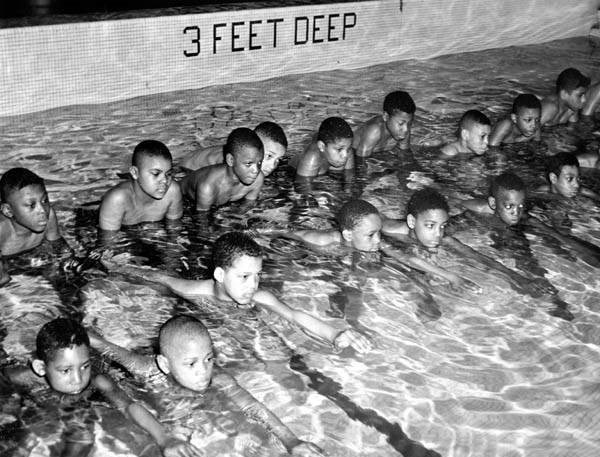
This image comes from the Cleveland State University archives in a collection called Cleveland Memory. The uni-racial nature of the swimmers is no accident , as in indicated in the following blurb from the website: Portland-Outhwaite Bathhouse Pool, located at the Portland-Outhwaite Center at 2511 East 46th Street, was one of only two pools in the Cedar-Central area that were open to Black swimmers prior to World War II.
As with their white cousins, these boys were likely told to get low for the picture.
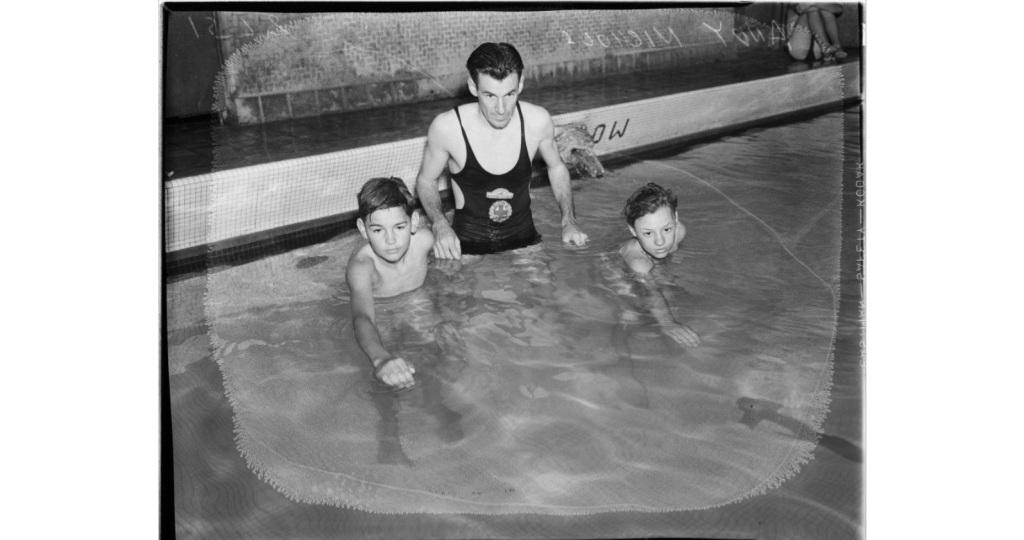
This photo comes from the University of Texas San Antonio library Special Archive. The source collection encompasses the years 1937-39. As before, the photographer made sure the boys were discretely low in the water. However, close scrutiny of the lad on the left suggests he may have not been completely successful.
More interesting is the non-participant seated on the deck in the upper right-hand corner. His hip seems smooth, suggesting that he is not wearing trunks. There is however a dark shadow between his thighs that might suggest some more abbreviated, bare hip suit like those worn by the figures in image 11 below.
Overall, it will be noted that the negative of this photo was damaged by contact with a fibrous material. The boy on the deck’s thigh was affected by the damage, adding further ambiguity to the image.

Under the heading of damaged images is this one held by the Colorado State University archives that is dated to roughly 1920. The location is unknown, but the venue is unusual both for its shabbiness and its configuration. This pool could be described as a trough. One has to wonder about the utility of such a narrow pool.
Returning to our topic, it is not readily apparent if these boys are nude or not. The subsurface shadows are ambiguous. However, a close scrutiny of submerged assets of the boy second from the left in the first row shows strong evidence that there are no suits being used.
One other item of note is that the figure topmost on the right appears to be an adult with only his head and shoulders above the water. That must be the deep end of the pool since the boys opposite him are clinging to the walkway, whereas those in the foreground are standing on the bottom.
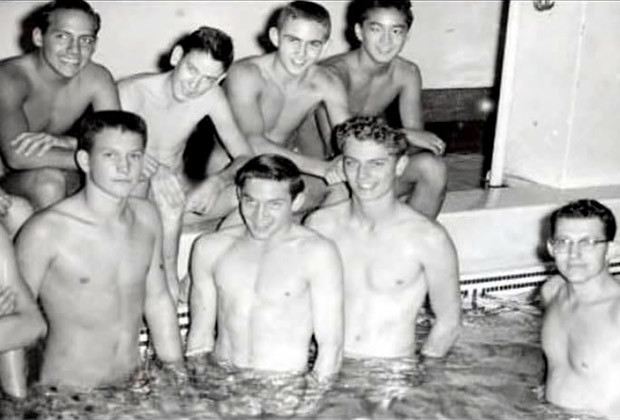
Here we have a group of older competitors with their coach (?). Some of their colleagues have apparently been cropped out. Everybody is positioned to frustrate ascertaining whether or not they were in their birthday suits.
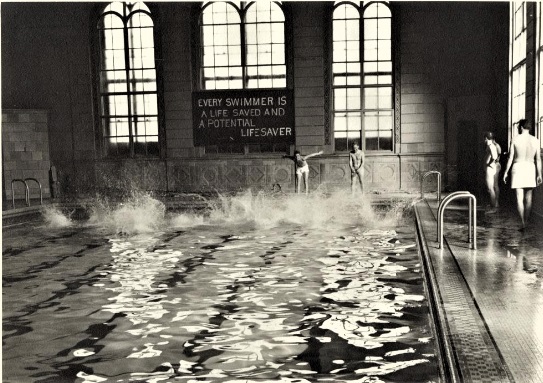
This is a scene from the University of Michigan’s Intramural pool during the period of 1941-1945. This image is from the Hathi Trust Photo Collection of the University of Michigan Libraries. There is no indication what sort of activity is occurring but it does appear a race is in progress. The figure assuming a diving pose seems to be in trunks while the person on the far right is in a wrap. Then it gets ambiguous. A close examination of the guy to the right of the incipient diver who is grasping his genitals suggests that he too is suited. The last figure at first glance appears to be nude, but the shadows and resolution may be conspiring to give that impression. He may also be wearing light colored trunks.
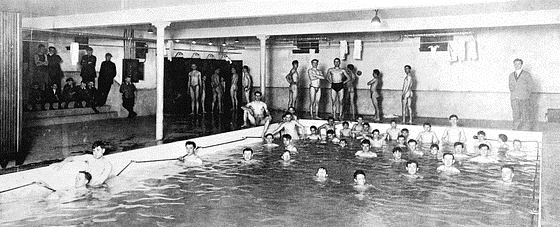
Although there are a lot of exposed buttocks, I’m inclined to believe that no one in this image is nude. The group on the deck seem to be trying to give the camera a view of their peculiar swim suits from every angle. The conclusion I draw is that despite the low hanging fronts, the back of the suit is little more than a thong. The one guy at the center of the image is remarkable in that he is turned out in a brief.
For what it’s worth based on comparison with other pictures in this collection, I believe this image to be very old. It may very well predate 1920 – maybe 1900.
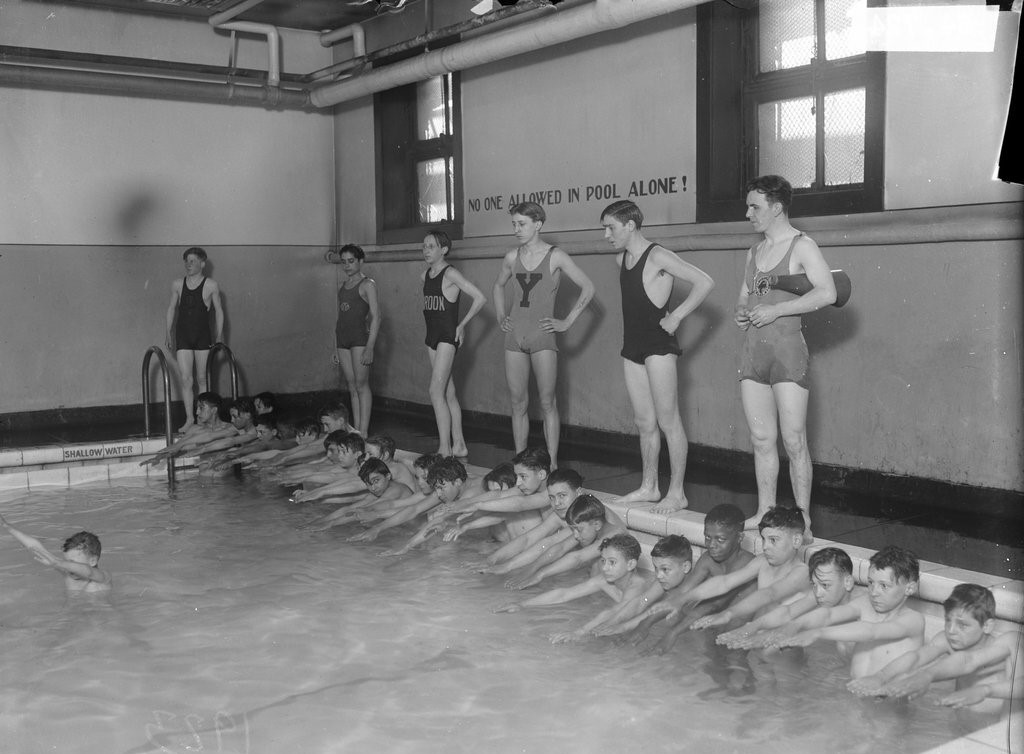
This 1924 attempt at a discrete photo at the West Side (Chicago) YMCA swim class didn’t completely succeed. (Nor did the instruction not to look at the camera.) If you take a subsurface look at the boy fourth from the right and the partially obscured dark-haired boy directly below the instructor with the big “Y” emblazoned on his suit, you will discern the bodily protuberance that most definitively identifies the male of the species.
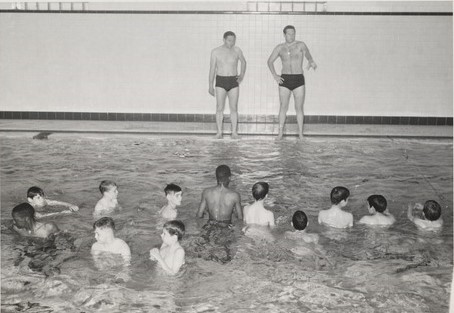
This image is attributed to “Bigelow Swim Class South Boston 1966.” It is included in an archive of Boys’ and Girls’ Clubs of Greater Boston images that is held by Northeastern University library. Having established the provenance, the class participants require scrutiny. Having a racially mixed group facilitates ascertaining that the boys are indeed nude. The reflection of their below surface bodies corresponds to their skin tone confirming that they are not wearing suits.
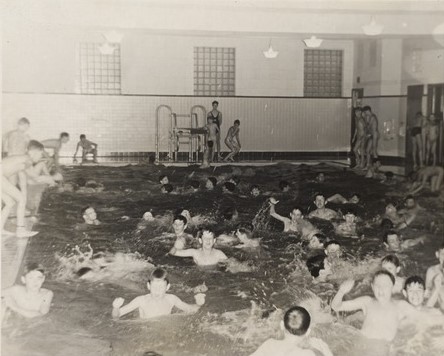
This is another picture from the Boston Boys’ Club archive held by Northeastern University library. It is dated 1942. The ambient conditions of high humidity and poor air circulation in these old, basement pools cause this image to be indistinct. Nevertheless, close examination of the figures on the deck makes it highly likely that all of these guys are nude except for the person in charge (tank suit, center) and what appears to be his assistant (trunks on far right).
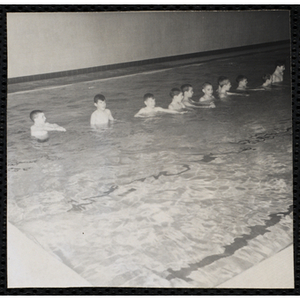
This line of boys is from a 1964 image. As with many of the previous offerings, the state of the boys is unknown. It seems however that the lad on the far left has a subsurface dark line around his middle. His adjacent classmates do not. Is he “that guy” who insisted on wearing a swim suit?
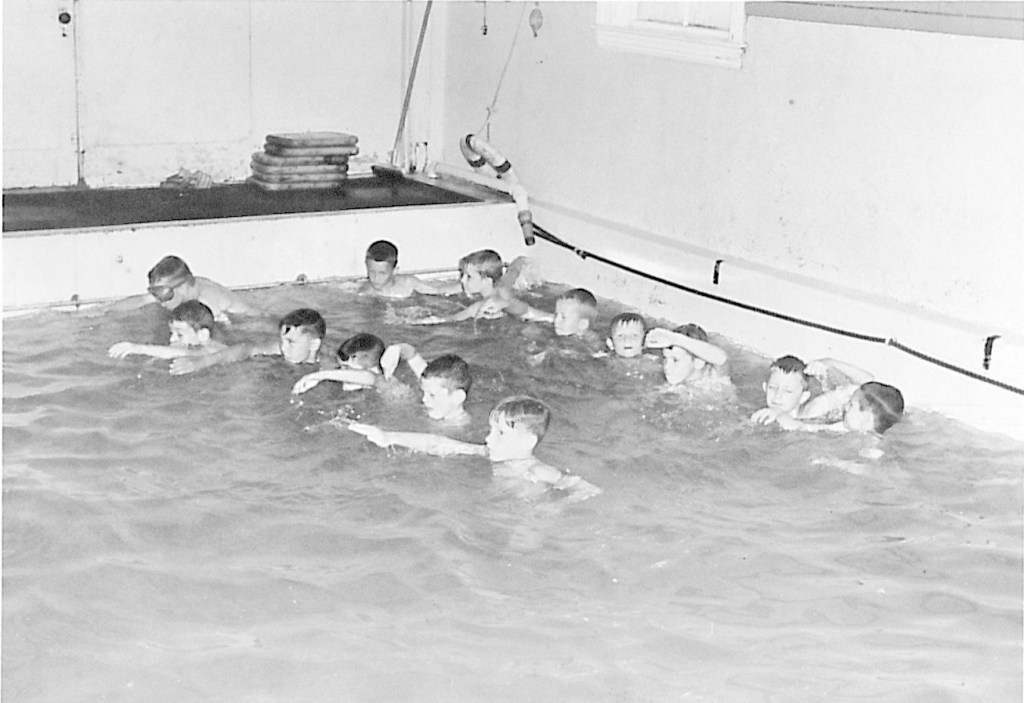
Ever heard of this island off the coast of Maine? Me either. Turns out, it is the second largest island on the US eastern seaboard, after Long Island NY. Also turns out that they had a YMCA in the 1950s and that this is a photo of a swimming class in that place and time. The subsurface appearance of the boy nearest the camera suggests that the class may have been conducted in the nude.

Sliding down the Maine coast to the state’s largest city, we have what is reputed to be a Red Cross Lifesaving class from the year 1926. It comes from the Maine Memories Network. Having related the official information, I have to admit that, not only is no class activity shown, but also that the boys seem on the young side for this kind of instruction. Nevertheless, close scrutiny below the surface of the boys up front seems to suggest that they are not wearing suits.
As an aside, the dressed boys in the background seem to be wearing street clothes with short pants and knee socks. That does comport well with the customary dress for prepubescent boys in this era.
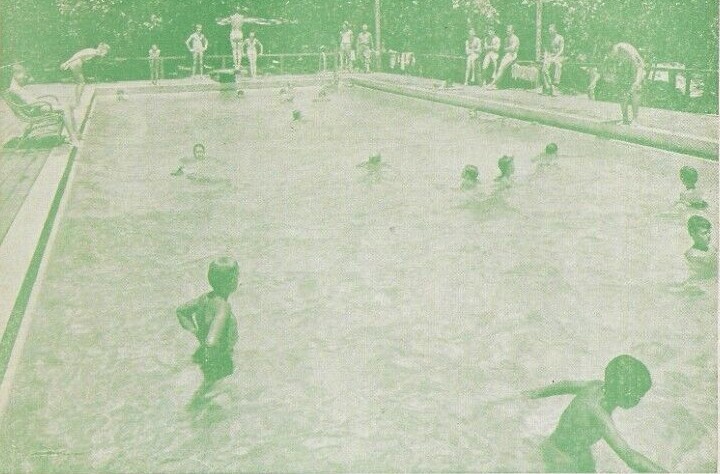
This image is from a four page brochure promoting a summer camp experience for boys in the mountains overlooking the legendary Napa Valley of California. The sponsors of this experience were the YMCA in partnership with the Army and Navy. Huh? I surmise that since World War II was at its peak in this year and no one could say how much longer it would last or what would come afterward, the military in the national interest wanted to insure an adequate supply of healthy, fit young men.
Returning to our topic of interest, the brochure advised that participants could bring a “bathing suit or trunks” many boys’ wardrobes probably did not include such an item. All resources had been devoted to the war machine, including textiles. I read that the sale of sewing machines to civilians was banned in the US during this period. Since swim suits were likely limited availability, my guess is most showed up at camp without. Incidentally, this same brochure included a photo of a camp baseball game. Curiously, all of the participants were shirtless and most were wearing long pants – perhaps the only pants of any length they owned.
Back to the picture above. Although the resolution is low, my evaluation is that most of the figures are nude, including the boy on the diving board and the boys at the far end who are presenting fully frontal. Take your own squint.
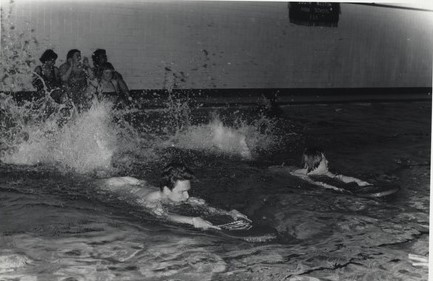
The archive that this image was lifted from identified it as from the Boston Boys’ Club. The collection spanned the years 1924 to 1993.
There are two points of interest: the apparent moon being displayed by the swimmer on the left and the silhouettes of the spectators. There is a possibility that the bare buttocks are covered by a very thin pair of white boxer shorts, but that seems improbable. He would be essentially naked anyway once he emerged from the water in see-through shorts. Which brings us to the spectators who appear to be a clutch of animated females.
The conclusion is that there is at least one a naked guy swimming in the presence of women. Or not.
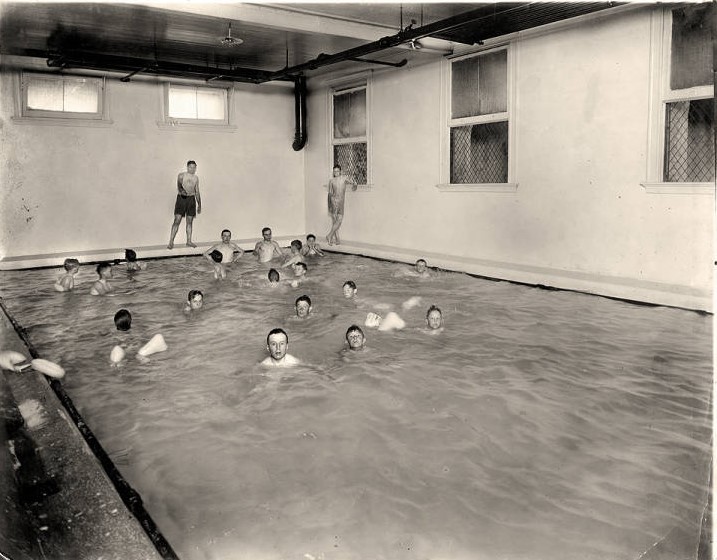
This image was sourced from the Houston Library Digital Archives. It is a scene from a YMCA dated 1920. It seems to contain males from a range of ages, some of whom are utilizing flotation devices. That suggests a swim class for beginners. As usual, the instructors on the deck are suited. How about the guys in the water? They are shoulders or neck deep, except for the one who is just the right of center and turned in profile. The length of his body appears white below the surface. That could be a reveal of another nude swimming class.
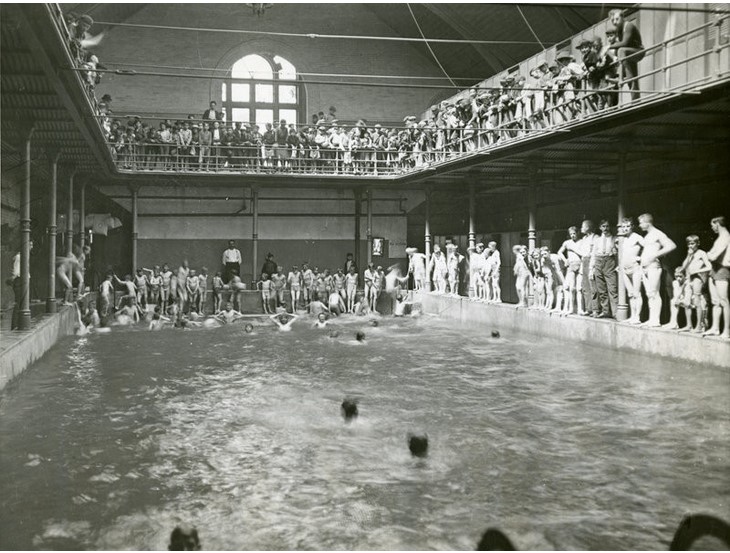
For those whose Latin may be a bit rusty, “natatoria” is the plural for “natatorium.” Apparently, the City of Milwaukee was a stickler for proper Latin usage in the late 19th and early 20th centuries.
Pictured here is the South Side natatorium which was opened 1894 (this might be opening day). It was one of the six or seven indoor bathing facilities built by the city, the first of which opened in August of 1889. These venues contained real, concrete pools, making them among the first in the US.
In this image you will note that despite the huge (all male) attendance, very few participants are in the water. This may be due to the fact that the pool exchanged water freely with Lake Michigan. It is reported that on some days when the lake was roiled by storms, the water in the pool turned … well, nasty. In fact, on opening day of the first pool, many of the large crowd of attendees refrained from entering the water for that reason.
The image itself seems to show all and sundry suited up on deck and fully clothed in the gallery. However, checking out some of the boys on the far left, it appears that some of them are sans suit. As it happens, there is a higher resolution version in which the outlines of thigh-length underwear can be made out on the “nude” boys. Everyone here is dressed. My guess is that this was a special occasion where some form of “suit” was required for the photo.
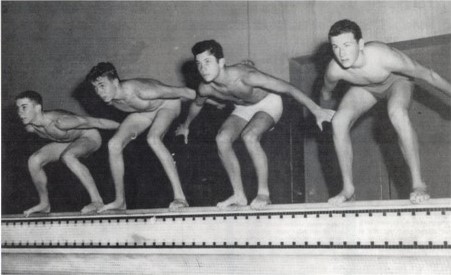
The 1950 Redlands High School (southern California) swimming team enjoyed huge success, setting records and winning championships. In 2016, the team was belatedly inducted into the school’s hall of fame. At that time, the old yearbook images were resurrected and published.
This photo appears to portray four athletes in swim suits. There is no doubt that the two on the right are so attired – one in white trunks and the other in a brief, perhaps a Speedo. The first point is that they do not match. Parenthetically, the 2016 article included a team pic in which everyone was wearing different suits. That could indicate that since there was no team suit, suiting was left to the individual and may have been optional.
Now check out the guys on the left. Having examined this picture closely, I’m more than 50% sure that they are unsuited and that the apparent demarcations at the waist and thighs are simply tan tines. This photo was likely shot at a practice when some of the members were not equipped for modesty. The photographer used the technique of putting the naked guys farther away from the camera while bent over in a starting stance.
Although these old black and white images can have tag-a-long shadows and markings that can be misinterpreted, I noted a bulbous shape subtending the thigh of the subject on the far left. Could this be an errant scrotal sack? Your call.
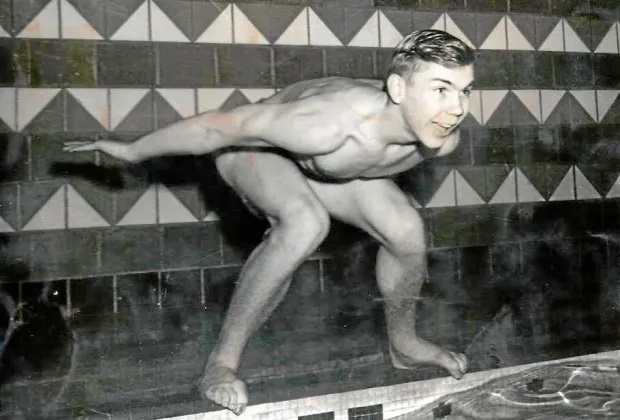
This eager looking lad is also a Redlands swimmer, though the date is uncertain. Although the lower portion of this photo has been rendered less distinct with time, the essentials seem clear. The young man assumed a swept-back pose that is curiously knock-kneed. The reason for this may be discerned by following the line of his thigh upward. My interpretation is that there is no discernible trace of a swimsuit. Like the two figures on the left of the previous image, I deduce that he may have also submitted to being photographed in his natural state. Or not.
Topic 2: Hidden in Plain Sight
In perusing old pictures of young males swimming, one might gloss over images in which the principle subjects are obviously suited or in which their immersion makes it impossible to ascertain nudity/non-nudity. As it happens there may be figures lurking on the periphery of such images that put a whole new light on them
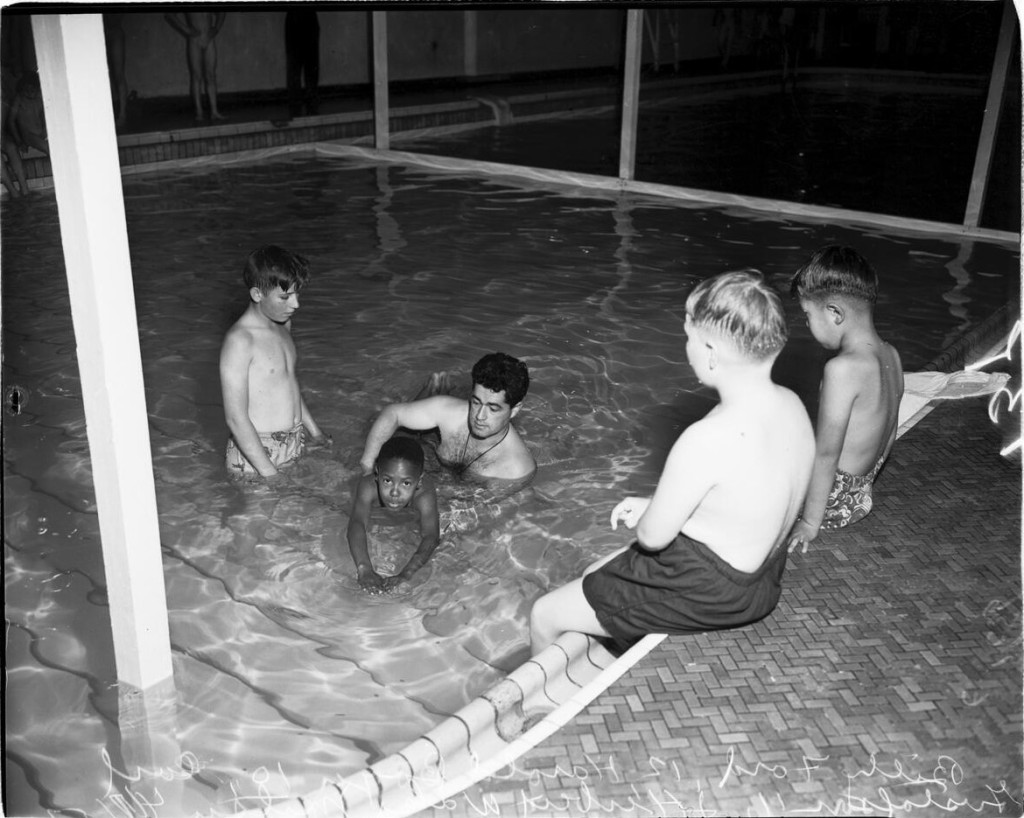
This image resides in the University of Southern California library archive. The subject matter is self-explanatory and it is clear that everyone shown is in a suit. Now look at the upper left. See anything?
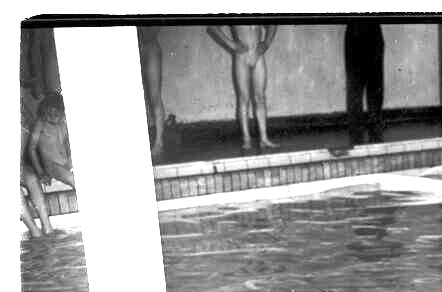
How about now? When you zoom in close and brighten up the corner of the photo, it shows naked kids. Apparently, when the camera came out, four suited kids were put in the frame. The rest retreated from camera range – or so they thought.
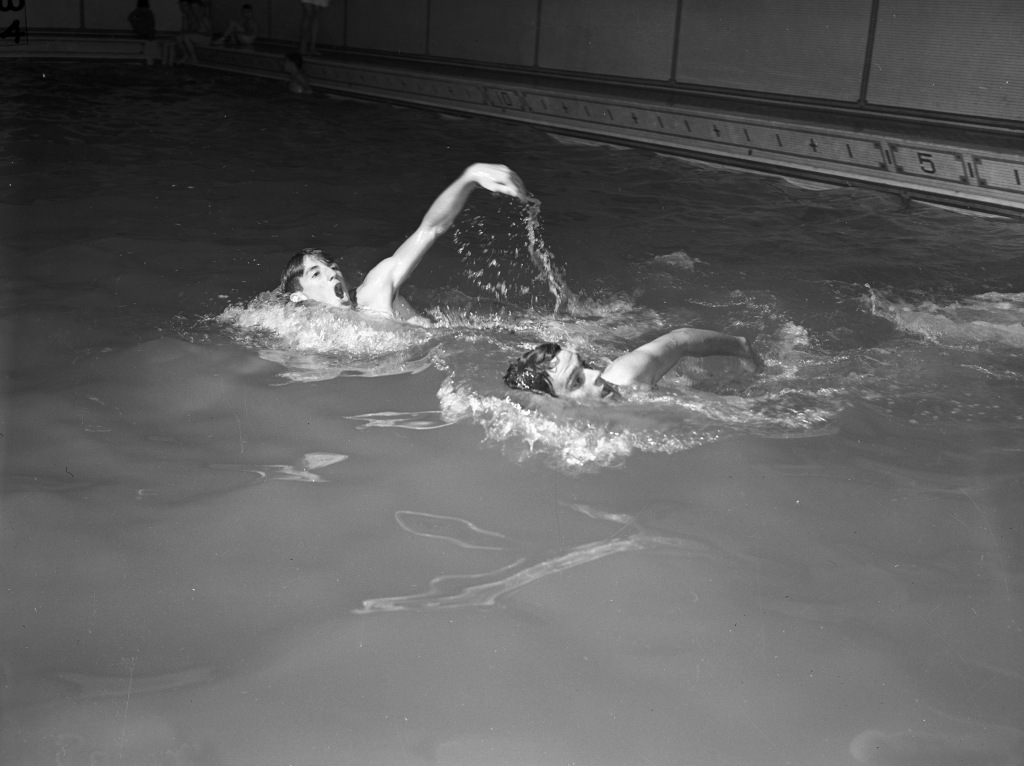
We’re in Arlington, Texas. The year is 1946. These two lads are members of the Arlington Heights High School swim team – the Yellowjackets. They are ostensibly practicing for their appearance in the first annual Southwestern Interscholastic Swimming and Diving Meet to be held in Dallas. This picture was being taken for publication in the Fort Worth Star-Telegram newspaper. This newspaper’s archives are held at the University of Texas – Arlington from which this image was plucked. This innocuous picture is quite a yawner until you examine the upper left of the frame.
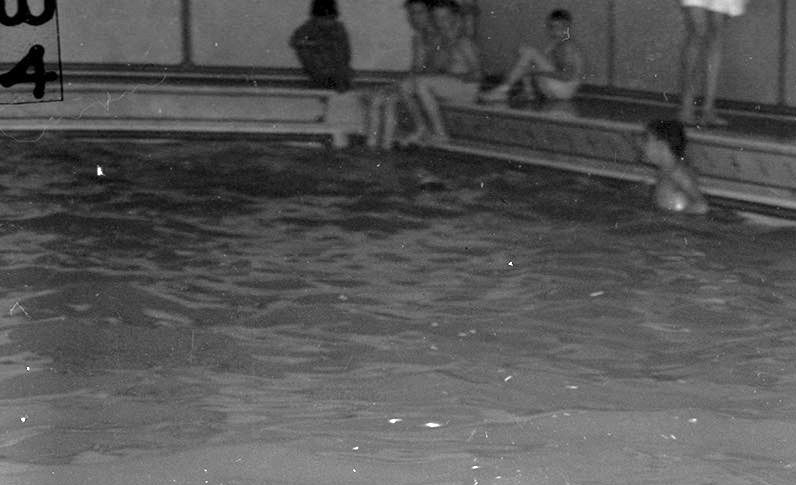
Out of camera flash range lurked the rest of the team waiting out the photo session. It is clear that these young gentlemen are practicing in their skin suits – raiment that is both handy and versatile.
Topic 3: Self-Censorship
The main thrust of this site is to investigate the authenticity of the nude male swimming images that are prevalent on the internet. This has involved outing the photos in which non-nudes have been rendered nude by forgery. However, there is a flip side of that topic in which nudes have been clothed by modifying the images. Usually, the modifications are made by the original maker of the image.
It seems that when a picture was ready for dissemination, someone held up a flag and warned “you can’t print that!” In that era of film photography, what that meant was that the negative would be doctored before printing. Here are a few clumsy attempts at protecting the public from the horror of male nudity.
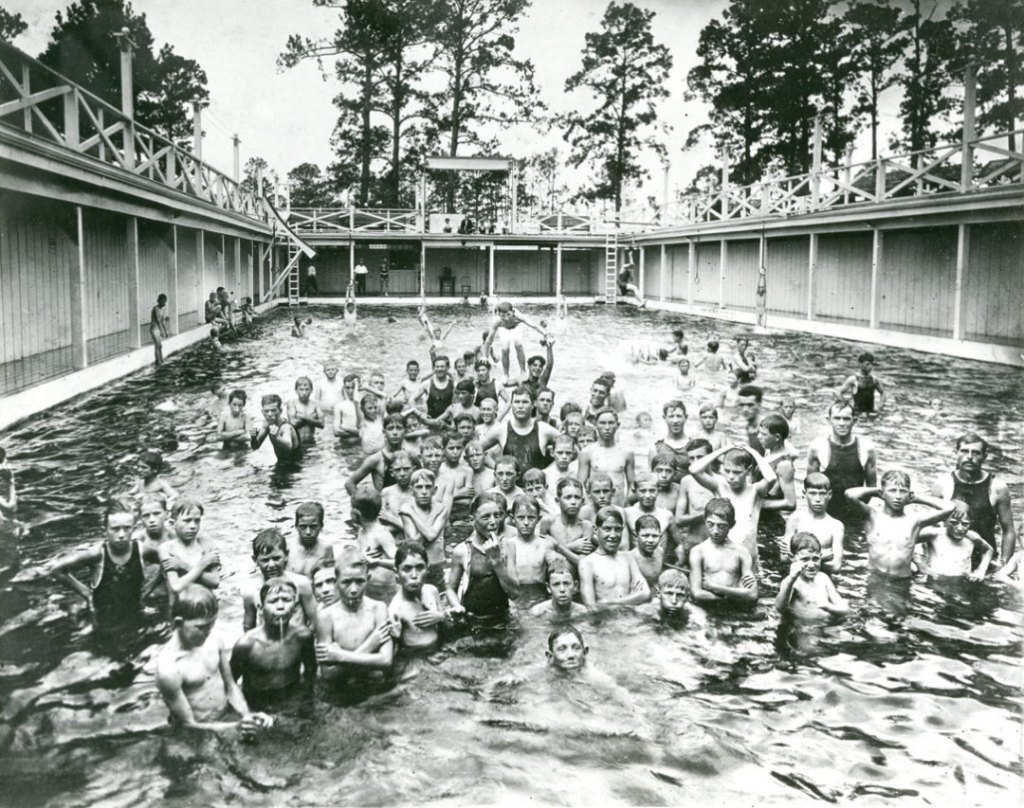
This photo is from the Houston Public Library archives. In the center of the frame you can see a boy standing on the shoulders of a fellow swimmer unlike his fellows who are all waist-deep in the water. You can also see that the area below his waist is surrounded by a white cloud, obscuring any detail. My guess is that that effect was achieved by scraping the negative with a razor blade, allowing the print paper to be fully exposed to the developing light. Mission accomplished: penis removed from view.
There is a bonus find if you look at the figure directly to the left of the central character against the walkway. He is obviously nude, but his crotch area has a frosty white film about it. Removal of the offending genitalia was not as complete, but probably determined to be good enough for the purposes of the publisher.
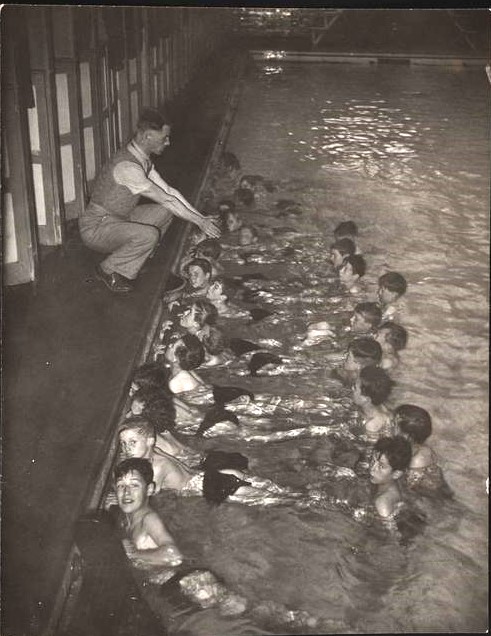
Sensitivity to nudity was not confined to this side of the Atlantic, apparently. This image was found in the archives of the British Science Museum Group.
At first glance, one might conclude this was a lesson that included only suited boys. A closer inspection, however, suggests that the suits were painted on. Take particular note of the lad second from the bottom whose trunks appear to be split and floating. I was advised that British boys taking swimming lessons in this period may have been issued suits that were this ill-fitting. Your turn: Is this a paint job?
One other note is that the British apparently persisted in the street clothes instructor/ moderator much later than the US. The photographic evidence suggests that American instructors had joined their charges in the water as early as the 1920’s.
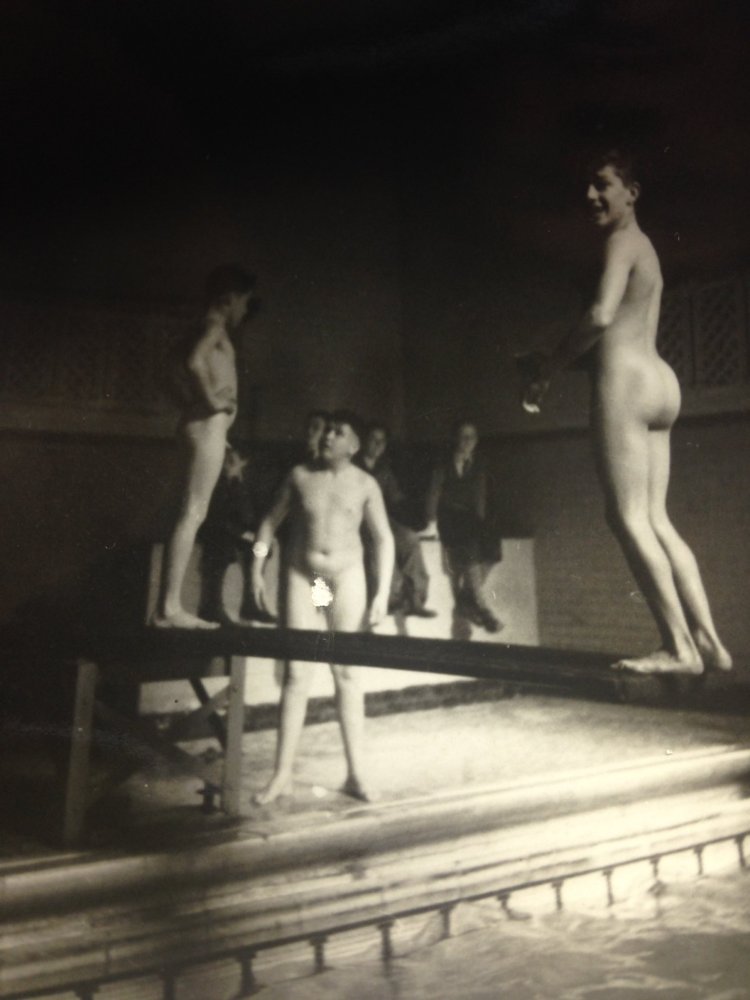
Pick a word somewhere between “flagrant” and “stupid” to describe this bit of photographic vandalism. Those familiar with the ancient art of film photography will recognize that this image was printed from a negative which had been scaped to remove the offending male parts. The joke is on the long-dead mutilator, however. The penis of the boy on the left can be seen jutting into view.
This photo is unattributed. Judging from the outfits on the clothed on-lookers, it likely predates the 1940s, around which time “knickers” (knee pants with long stockings) went out of fashion in this country. The primitive diving board comports with that dating.
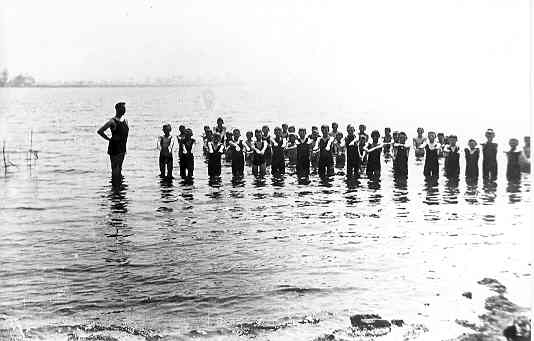
I continue to be mystified by the arms-out pose assumed by every swimming class in these old photos.
This one is from Victoria, Australia and dates to about 1900. The text that accompanied this image read as follows: Male children from Cobden Primary School No.864 receiving swimming instruction from a teacher at Lake Elingamite, several km from Cobden. Children in the far back row were placed there because they did not have any swimming costumes, hence they were nude. Thanks for that clarification.
Of course, one has to scrutinize this picture for the nude kids. It looks like the uniform of the day was a tank suit that covered from the shoulders to just above the knee. Looking for exceptions to this rule, you can spot the kid in the back, center right. His torso appears lighter than most of his fellows, suggesting he is one of those special people. However, in spite of the fact that he is standing in knee-deep water, there is no revelation in the offing. It appears that he is in trunks. I suggest that when photographer noticed that one of the nude boys was caught in the frame, he remedied the offense by dabbing some ink on the negative, covering the boy’s lower regions. Disaster averted.
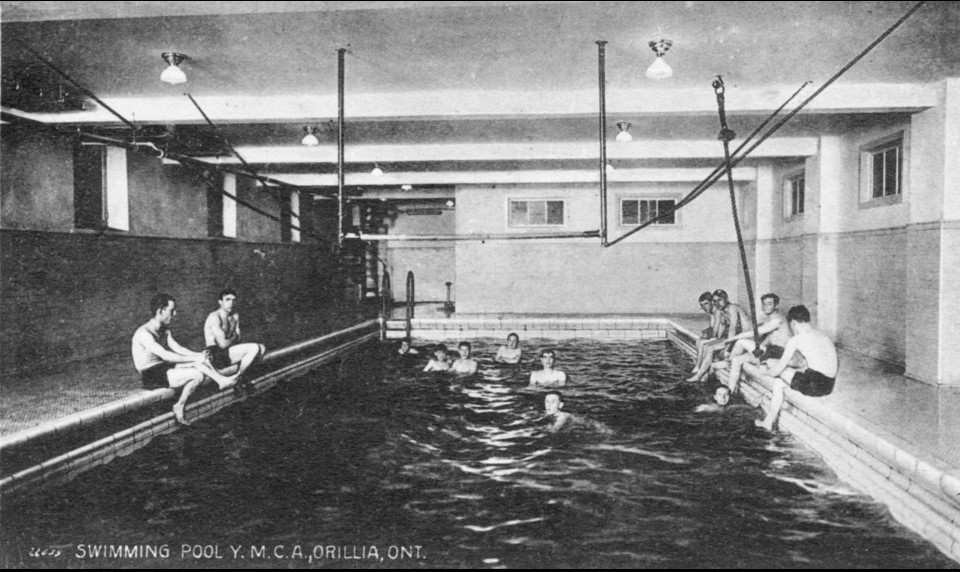
The file name on this image includes the word “edited.” Probably a “tell” on what you can see by examining this photo. Although the darkroom editor was more skilled than in some of the other examples, the bathing suits (all identical) seem drawn in. The figure on the far left doesn’t seem to be quite tucked into his suit. This looks like it may have been a postcard produced by the Orillia, Ontario YMCA. Apparently they were more skittish about bare buttocks than some.

This image was associated with a BBC production telling local histories in pictures. It’s likely that this is a scene from the Coventry (UK) YMCA. That YMCA started in operation in 1888. Looking at the fine mustache on the adult on the far right, the rather crude basement environment and the overall quality of the image, it seems likely that this scene predates 1900.
Another point is that there appears to be a swimming lesson in progress. The instructional method being used is what I call the buddy system. Two buddies are supporting a student in a floating position as the latter attempts to learn the swimming motions.
However, the reason for this posting is the appearance of the boys standing on the deck. They seem not only bereft of swim suits, but also their gender-specific apparatus. It appears that a little darkroom processing has blurred the area of their crotches.
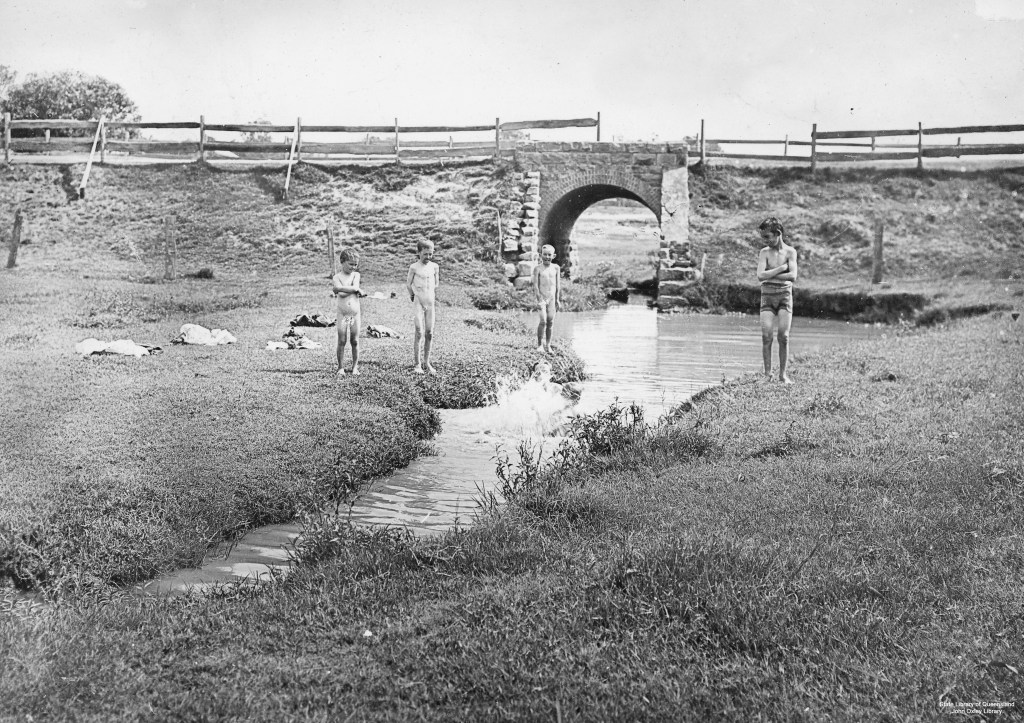
This undated scene was recorded in a creek in a place called Wooloowin in Brisbane, Australia. It comes to us courtesy of the State Library of Queensland. This high-quality photo of an appealingly innocent episode in the distant past apparently offended someone’s sensibilities. If you look closely, you’ll see that that the gender-pertinent organs of the three nude boys have been defaced by scratching the negative. More photographic vandalism.

The Providence Journal (Providence, Rhode Island) archives yielded this Frankenstein product. The cartoonish bathing suit would fool nobody, but since this was reprinted in 2023, accommodations had to be made to meet modern “community standards.” Or was the damage already done when it was first published?
Topic 4: The Finnish Natatorium
This image appears frequently without attribution on sites that deal with our topic.
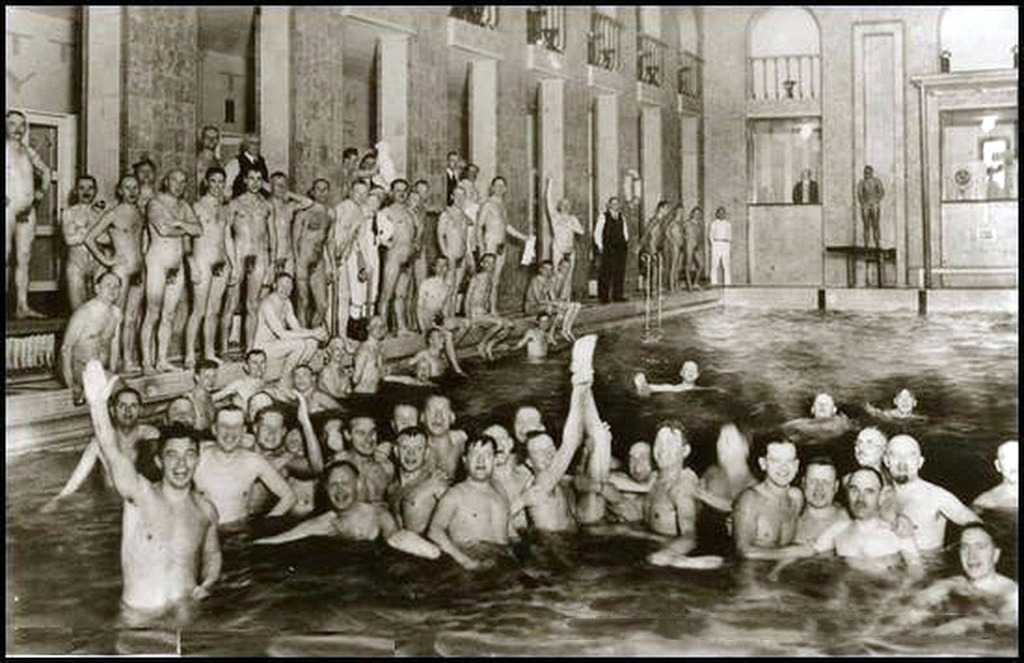
The complementary image below shows the other side and end of this ornate facility.
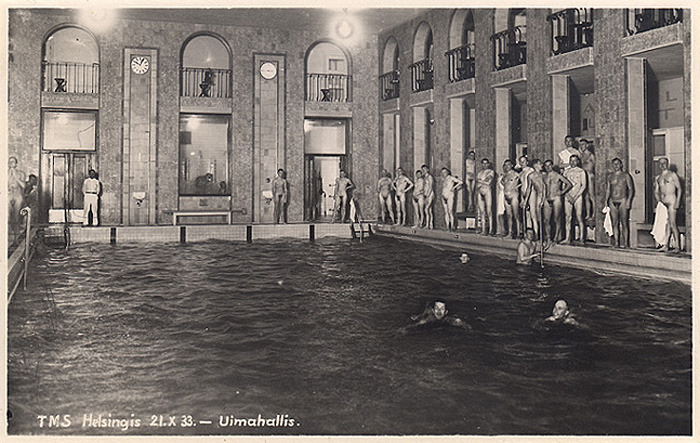
The inscription on the second photo identifies it as a swimming hall in Helsinki, Finland. It turns out that this is a venerable facility of great renown in that part of the world.
This 1937 picture shows the diving tower as it appeared then.
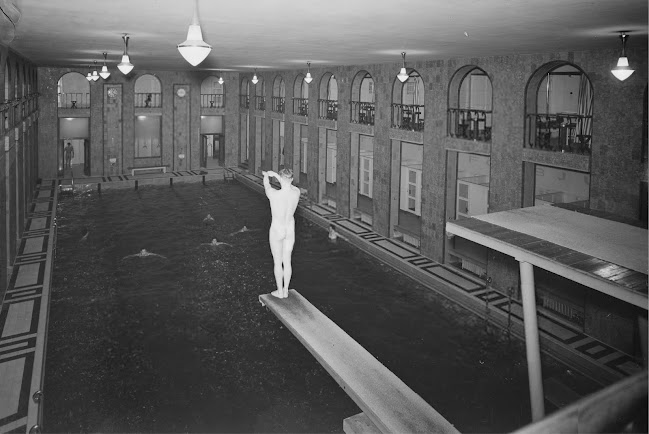
This next shot is of the facility in 1968 when it marked its 40th anniversary. Note the naked male patrons who are unconcerned about the presence of the woman on the upper balcony. She in turn is ignoring them.
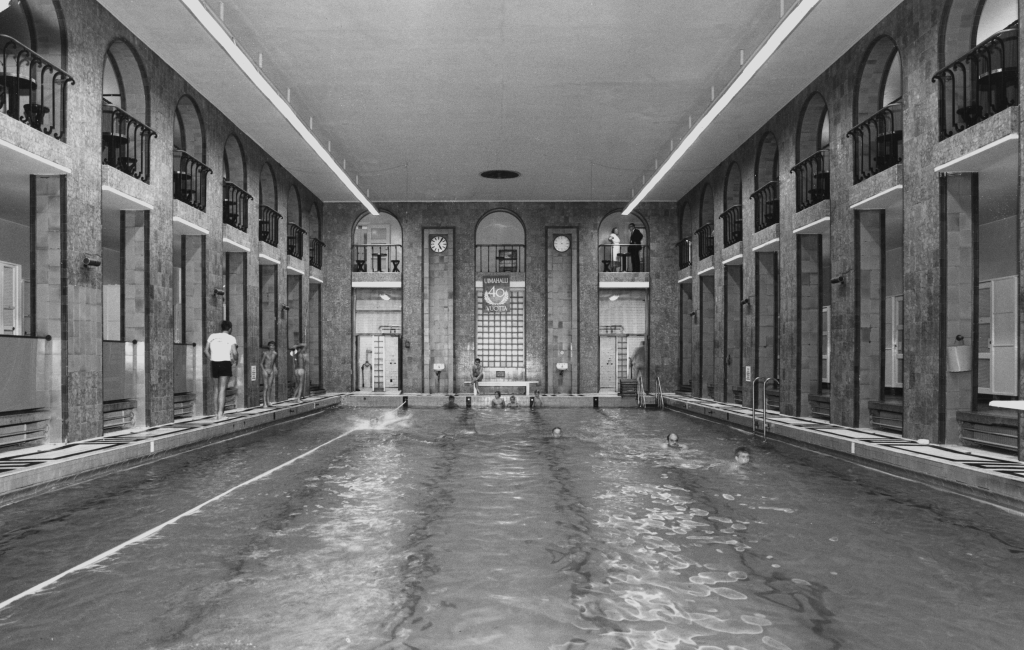
The first day ceremonies are captured in the picture below and explained in the accompanying text.
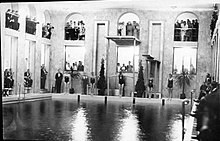
The Yrjönkatu Swimming Hall is the first and oldest public indoor swimming pool in Finland. It was inaugurated on 4 June 1928, and it took a long time until a second indoor pool was opened in Finland. The pool is located in the Kamppi area of Helsinki at Yrjönkatu 21b, and is owned by the city of Helsinki.
The hall building was designed by architect Väinö Vähäkallio and represents the Nordic Classicism style. It was inspired by the Centralbadet swimming hall in Stockholm. The hall was originally privately owned, but was transferred to the Finnish Sports Federation in 1954 and to the city of Helsinki in 1967. The hall was renovated from 1997 to 1999.
The Yrjönkatu Swimming Hall’s first floor contains a 25 × 10 metre pool, two saunas and dressing closets at the edges of the pool. The second floor contains resting cabins, saunas and a café. The hall sells two kinds of tickets, providing access either to the first floor only or to both floors. Traditionally, people swam naked in the pool, but since 2001, the wearing of a swimsuit has been permitted. Men and women have separate days for swimming.
Although quite irrelevant to our study, the Finns deserve plaudits for their persistent dedication to nude male swimming.
Topic 5: Promoting the YMCA to Adults
In previous postings I have made numerous references to the “Y”’s publicizing its aquatic facilities for recreation and for instruction of boys. Given that it was a “men’s” organization by name and intent, it should not be surprising that it made separate appeals to adults. A few examples of the materials used are presented below.
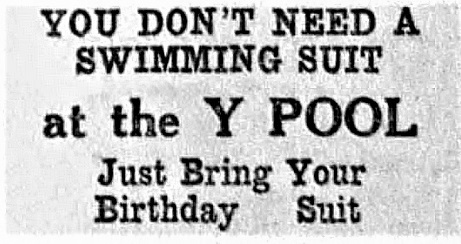
This notice is unattributed. It may have been a wall placard or may have appeared in a publication. The intent however is clear: The Y was not coy about inviting men to participate in nude aquatic activities.
Since most men were not practicing nudists, what was the “hook?”
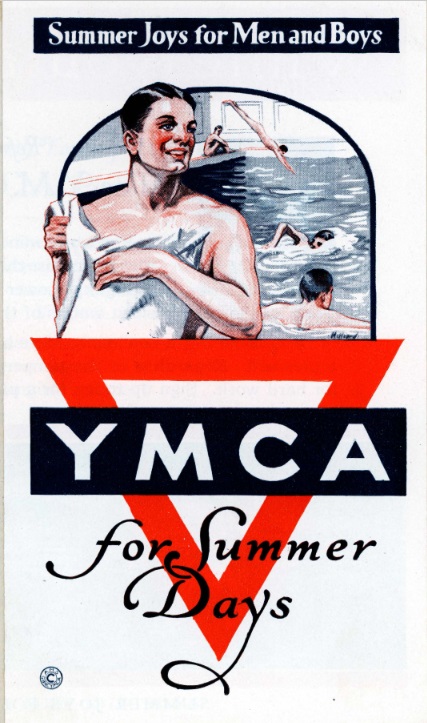
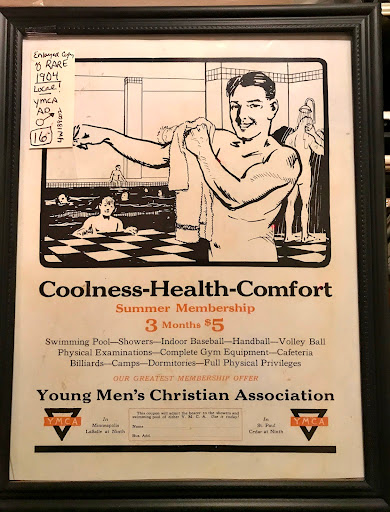
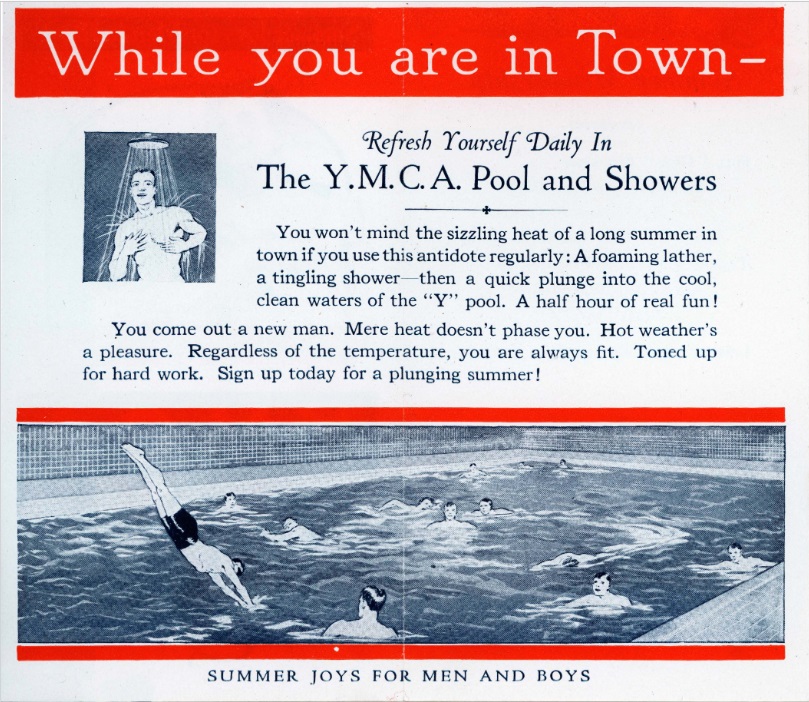
As shown in these outtakes from advertisements, relief from summer heat was what the YMCA was selling to adult males. In the first half of the 20th century, home air-conditioning was rare in most parts of the country. (Actually, mechanically cooled office buildings and factories were equally unusual.) Moreover, urban apartment bathrooms did not necessarily contain showers – just bath tubs. You can imagine that filling up a tub with warm water for a bath and immersing yourself in it probably left you sweating when you emerged into a warm, humid room. The only remedy was to refill the tub with cold water and take another plunge – a real time consumer. The YMCA had the solution. For a nominal fee you could shower off your sweat and chill out in the pool. If you did this in the late afternoon and brought a change of clothes you could pursue your evening recreation in comfort.
Returning to the images themselves, the first (where the guy’s hairdo might be from the 1920s or earlier) unabashedly shows naked men in the background. A similar image below it was apparently framed and offered for sale. The hand-drawn tag states that it is from 1904. It was a product of the Minneapolis-St. Paul area YMCAs. I’m not sure what the phrase “Full Physical Privileges” refers to. The guy in the foreground and the figure in the shower behind him are obviously nude. The third shows a diver in trunks – no doubt a bow to community sensitivity. The text, however, is a compelling sell.
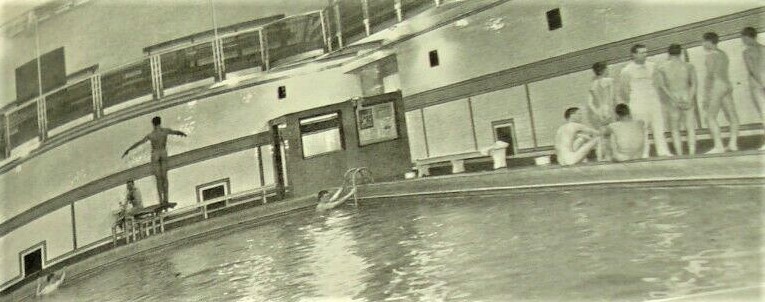
Later promotional brochures contained actual photos of the boys at play. This one was put out by a Boston Y in 1936. The nudity of the patrons is undeniable. However, the only guy who is frontal to the camera seems to have a fog-bound mid-section. We saw this technique used in the Self-Censorship section above.
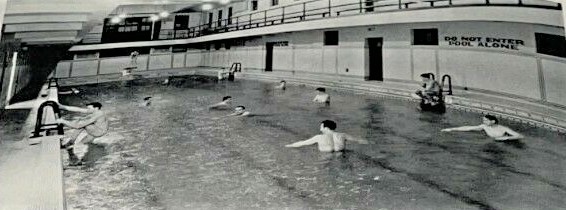
A similar photo was contained in a Worcester (MA) brochure, probably from the same era. On the left there is a nude fellow climbing the ladder. The opposite ladder also seems to be occupied by a naked individual (or two?).
Not to be outdone, the Cleveland YMCA published a regular newsletter aimed at the young male population of that city. Here is the front page of the May 30, 1912 edition.
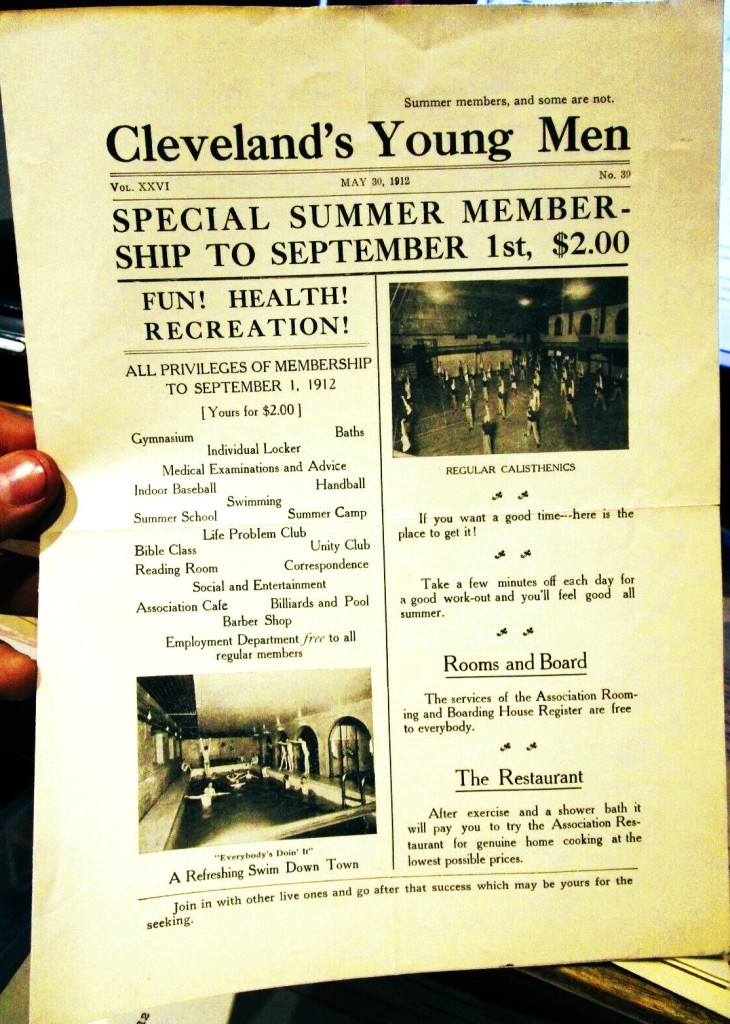
It promotes what sounds like a very affordable seasonal membership that not only includes the pool and shower facilities but also the live-in accommodations, sports opportunities, what sounds like counseling groups and – wait for it – Bible study!
Nevertheless, they are not shy about graphic representations of naked males at play. Here are some included photos.
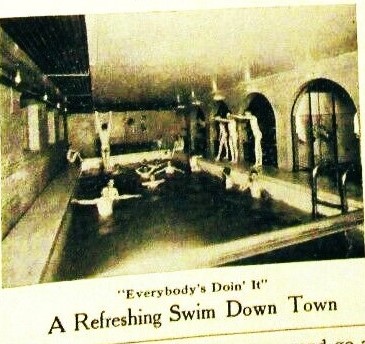
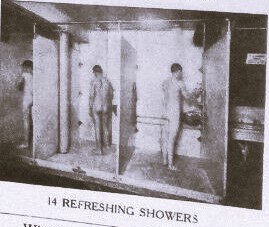
In the 1920s another Cleveland “Y” on the West Side put out a multi-page promotional booklet. This was a high-end publication with specialty text fonts, a colored logo on cover and a string binding. Here is the pertinent page.
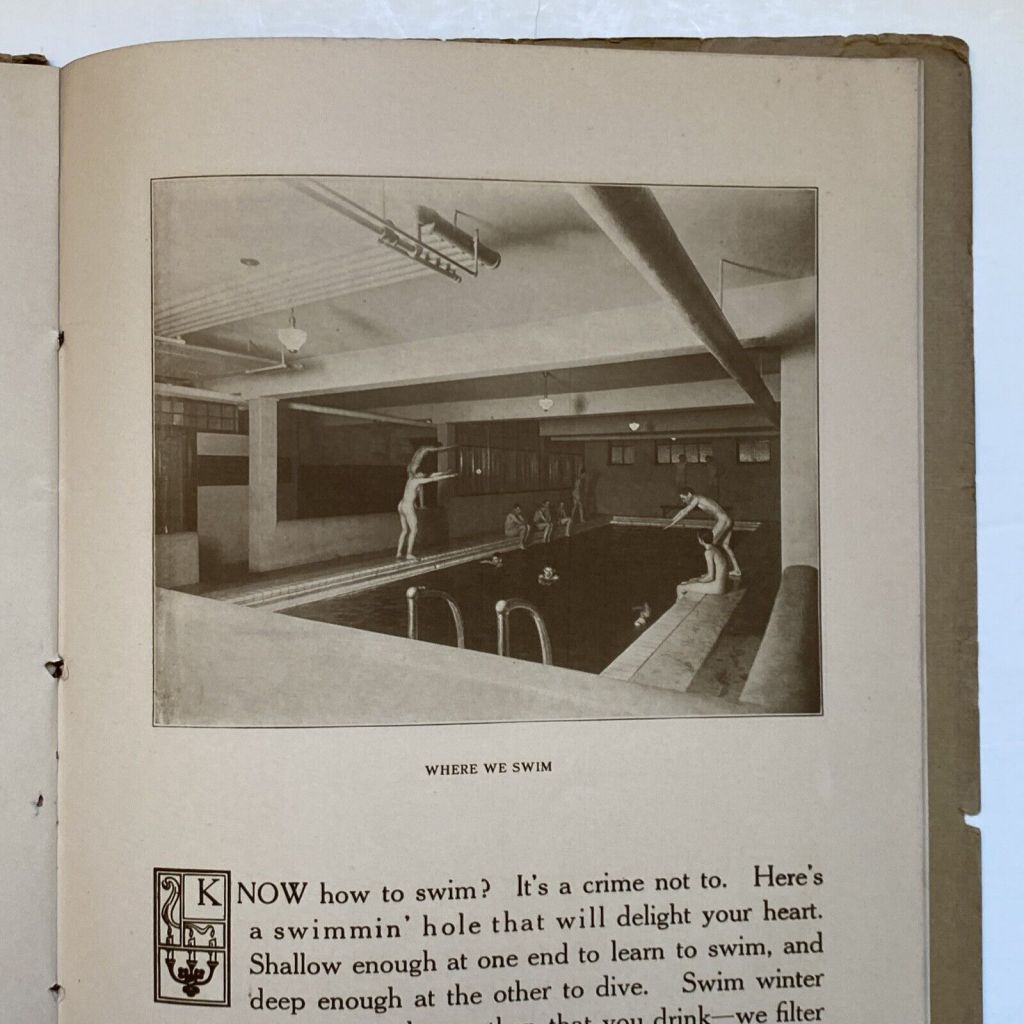
Here is a blow up of the photo.
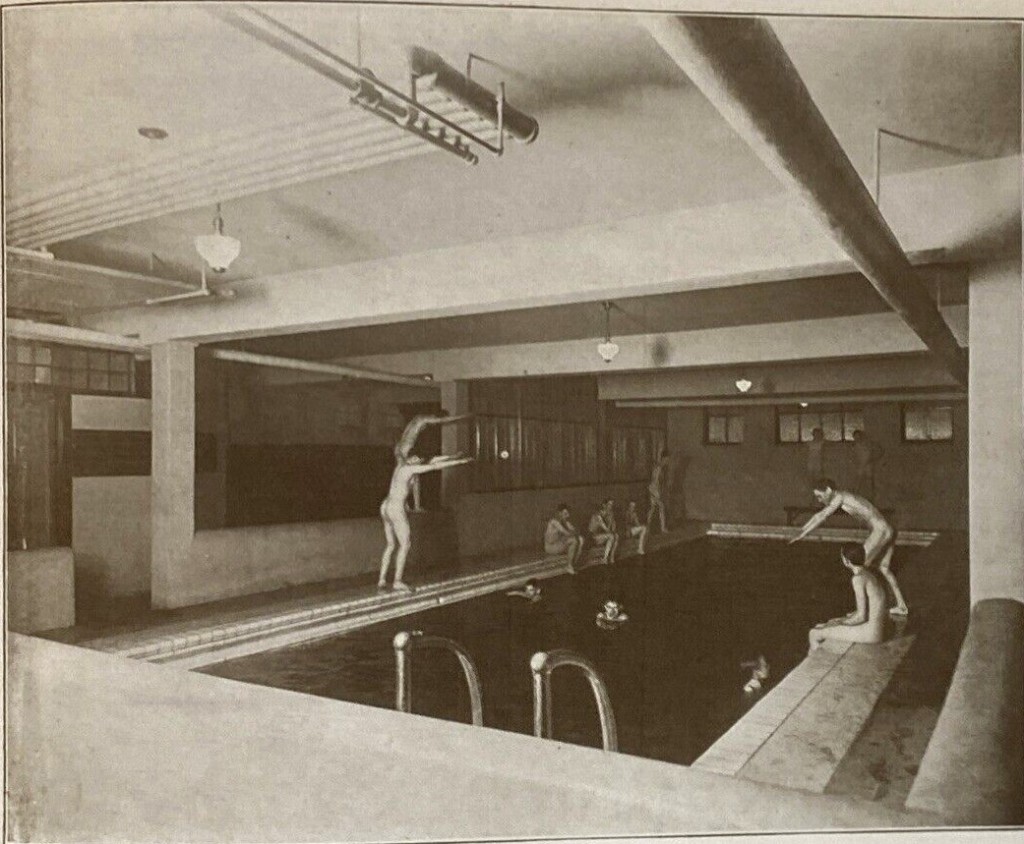
The naked guys on deck are assuming the classic poses: knees together for the seated figures and fake diving postures for the standing guys. Note the figure that seems to be standing on a half wall some distance from the water acting like he’s diving.
In addition to the graphic picture, some of the text in the booklet compares the swimming facility to the “old swimmin’ hole” – apparently a euphemism that conveys swimming here is in the nude. No misunderstanding.
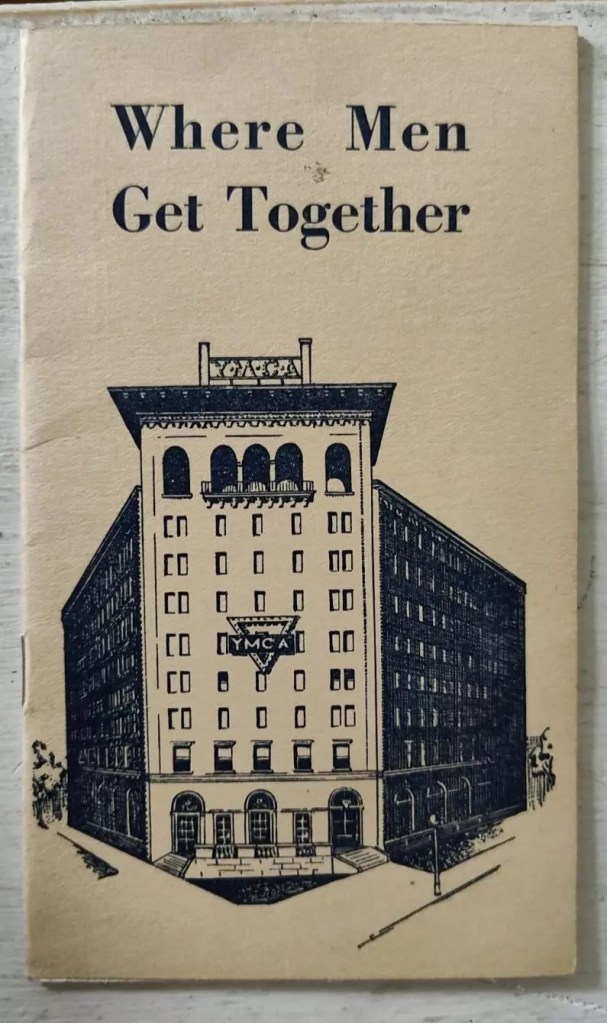
Not to be outdone, the Rochester, NY Y published a 17-page brochure in the 1930s. The slogan on the cover makes it clear what they’re about. The information in this publication included hours of operation, holiday closing schedule and requirements for a physical in addition to the usual description of facilities and activities as well as much more. It seems more like a members’ handbook than a promotional flyer.
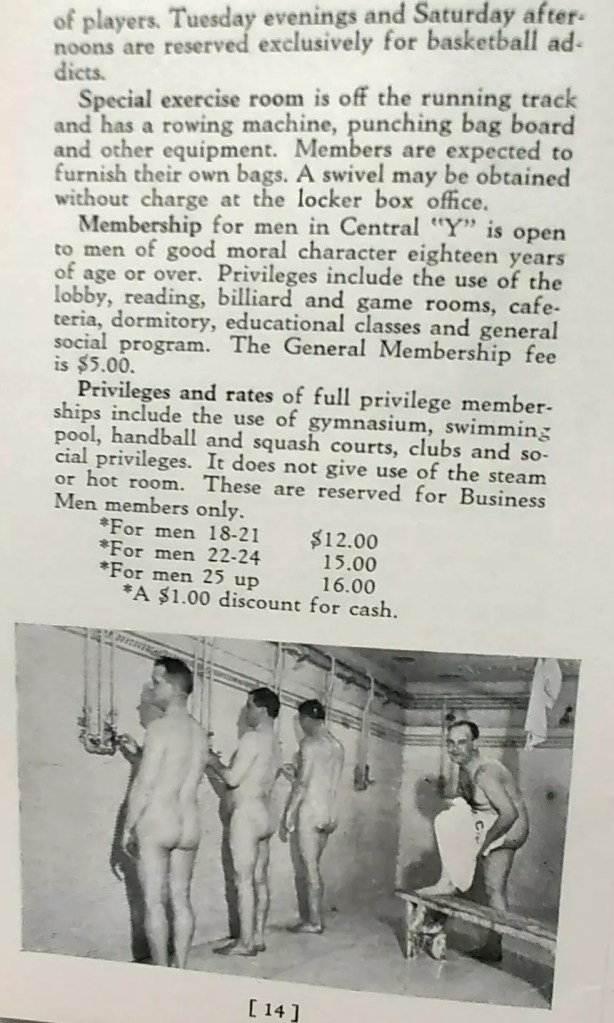
Note the schedule of membership levels and fees. The dollar discount for cash was in recognition that checks carried bank fees back then and there were no credit or debit cards.
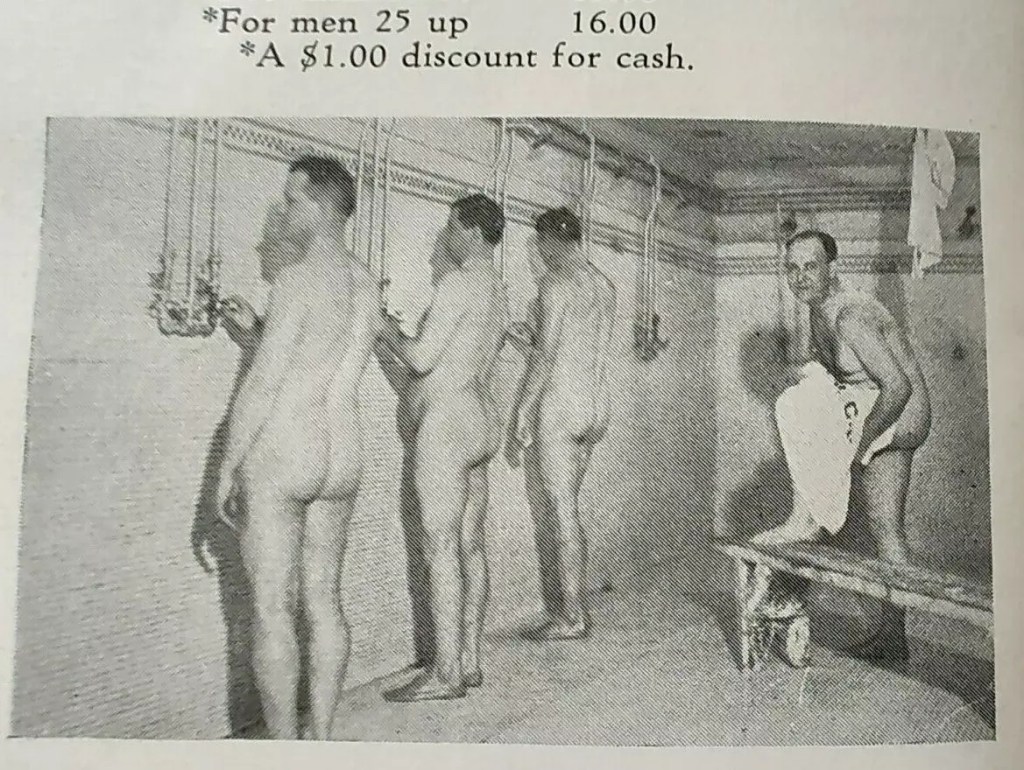
The shower scene is reminiscent of the Cleveland brochure, above. One wonders if shower scenes were required in these promotions. This looks like a staged shot rather than a candid. The models were all consenting.

The Central Branch of the Richmond YMCA put out folded leaflet promotion in 1932.
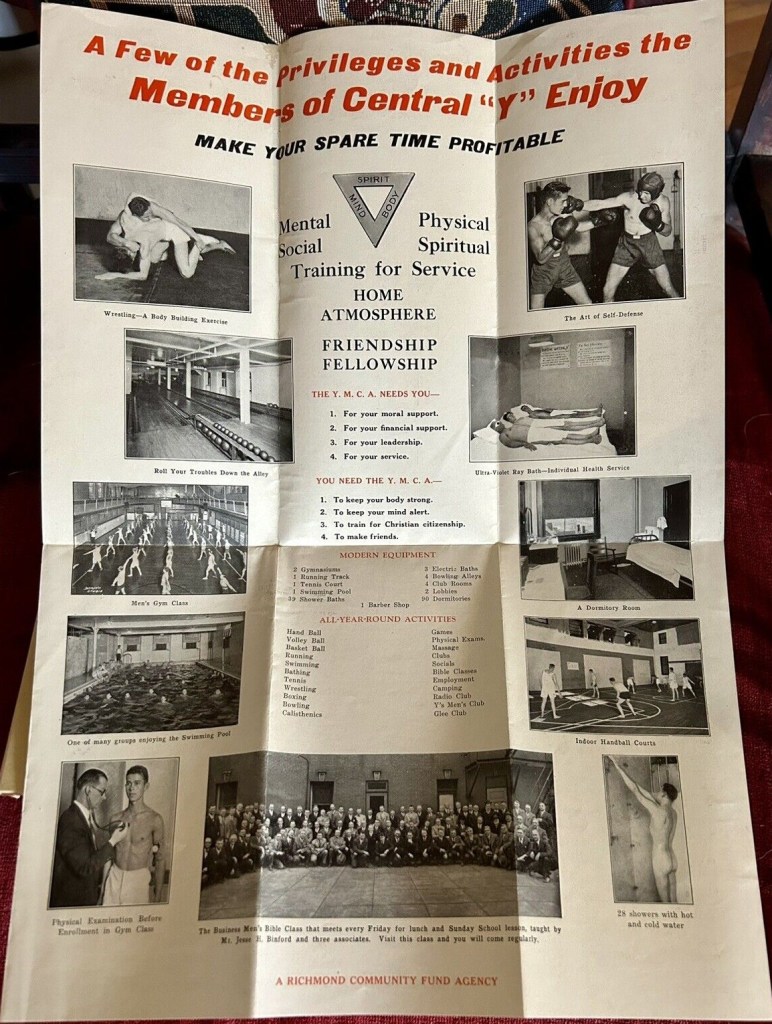
The folded-out interior was well designed to give a comprehensive overview of the Y’s offerings. It should be noted that the most prominent feature was the large group photo at the bottom. It was of the bible study group. The caption promised that one visit would keep you coming back.

Of course, there was the mandatory nude in the shower photo. It was somehow necessary to stipulate that the showers had both hot and cold water.

Although the pool photo is rather low res, the bare buttocks on the deck are clearly in evidence. Check that box. (A better version of this photo appears in the Swimming Lessons posting.)
The YMCA’s appeal evolved with the times.

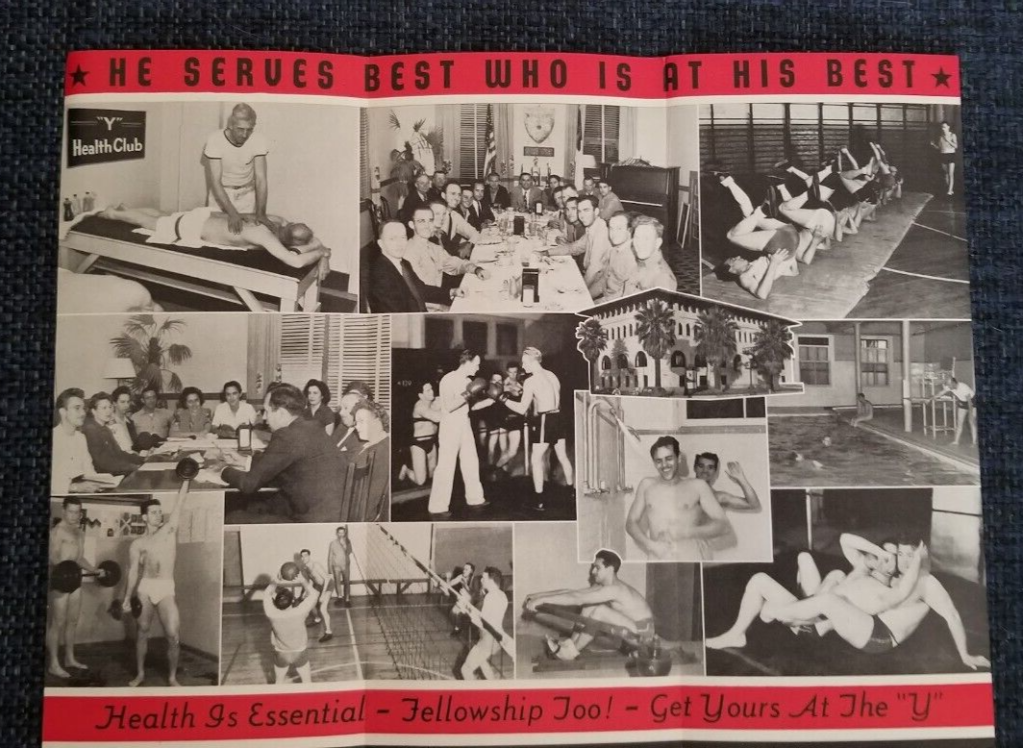
During World War II, the YMCA adapted its message to the mood of the times. It became one’s patriotic duty to be fit, strong and ready. Of course, the audience was different as well. Millions of prime aged young men were in the military, so it was the left-behinds – men that were older, had physical disabilities, worked in essential industries or had families – that were being courted. Perhaps because of that all of the figures are modestly attired for the situation. Even the shower scene is cropped with care. The only exception is the mandatory swimming pool photo on the right middle.
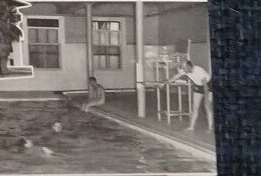
In this detail it shows an unadorned buttock of a swimmer taking respite on the side of the pool.
This tri-fold promotional brochure is from Phoenix, AZ. That explains the picture of the club exterior that includes palm trees.
Promotion of the YMCA was accomplished by other media as well. In the first half of the 20th century, the postcard was widely used for a number of communications including seasonal and holiday greeting cards. Advertisers would produce postcards with graphics that promoted their products and services, perhaps free of charge just to induce correspondents to use them. Here are two examples of YMCA promotions.
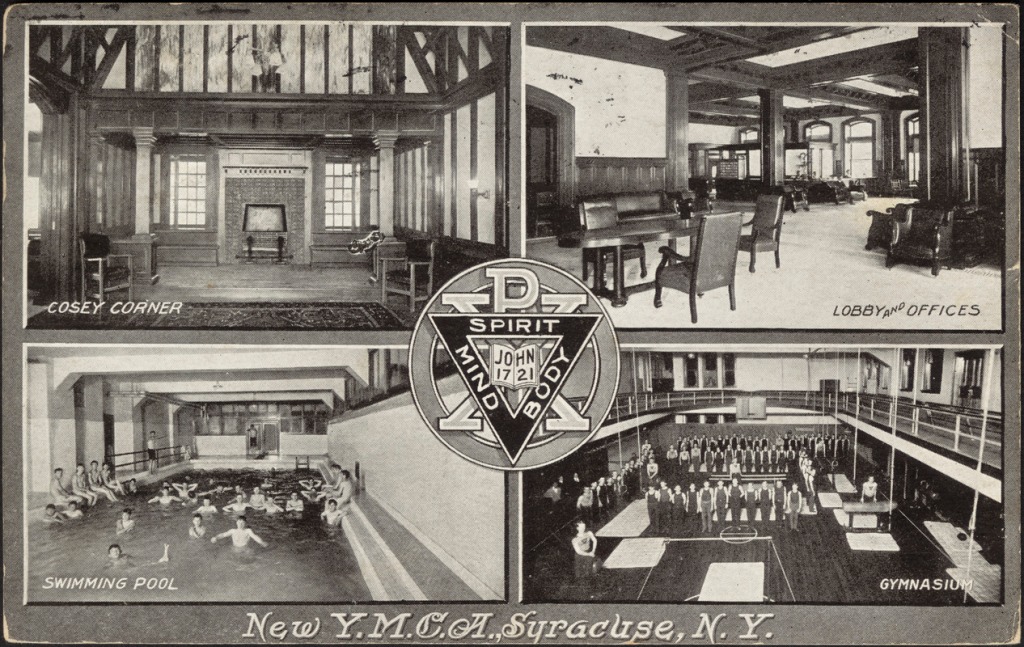
This production of the Syracuse, NY YMCA (courtesy of the American Publicity Co. of that city) was used to convey a personal message from a son to his mother reporting his safe arrival at his new domicile. It was postmarked July 7, 1909. The graphic clearly presents the appealing appointments of that Y. For our purposes, the lower left-hand image labeled Swimming Pool invites examination.
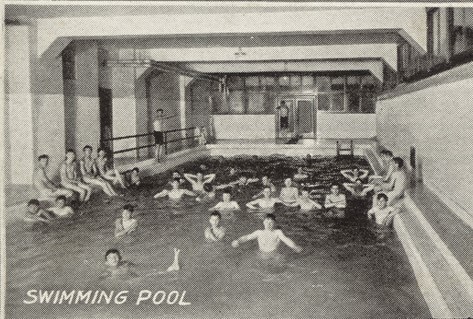
In this detail it is clear that the boys perched on the side of the pool are nude but carefully presenting only bare buttocks to the camera. It is instructive that this subject matter was considered not only acceptable mail media but also suitable for a man to send to his mother.
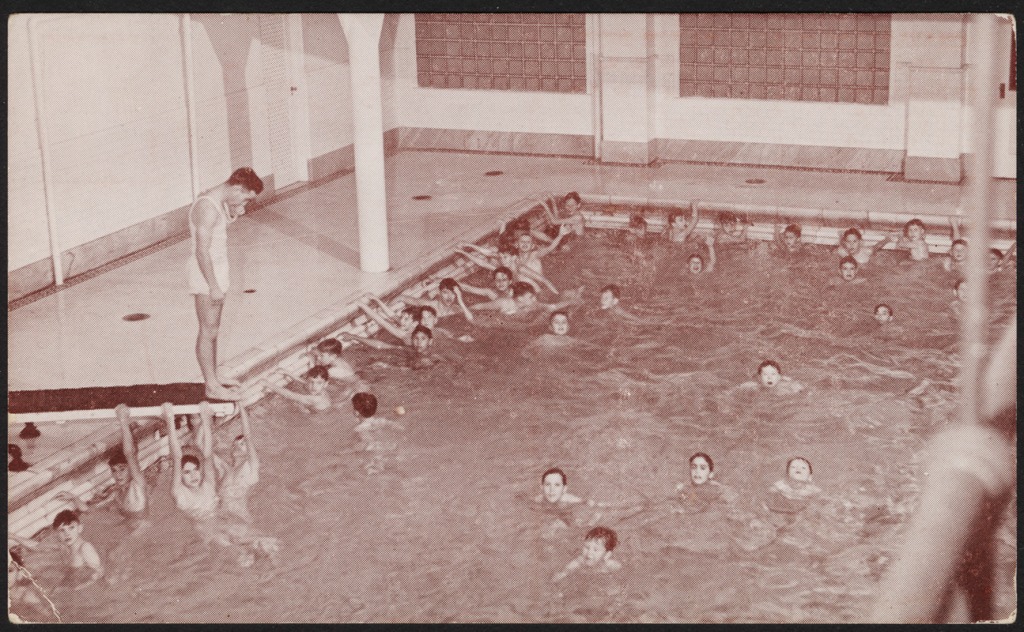
This undated, unused postcard of the Charleston, SC YMCA has no nudes on the deck, but thanks to the boys hanging from the diving board the unclothed state of the participants seems clear. Although the card has no text on its face, the obverse of this card contains a lengthy description of the swimming facilities extolling their modernity and including hours of operation. That text encroaches somewhat on the space normally reserved for the user’s message. The user could not have avoided reading the advertisement.

Here is a bit of an outlier. This promotional brochure doesn’t solicit new members, but rather donations to the Y. It is from the Camden County YMCA located in Haddonfield, New Jersey. Although undated, some contextual information suggests that it was published around the 1920s.
The crude cartoons depict various desirable attributes of that institution. The naked diver in the upper left seems like a clear reference to the nude swimming custom. At the same time, the graphic on the lower left extols the Y’s promotion of church and religion. The take away is that nude male swimming is wholesome activity that is not in conflict with conventional Christianity.
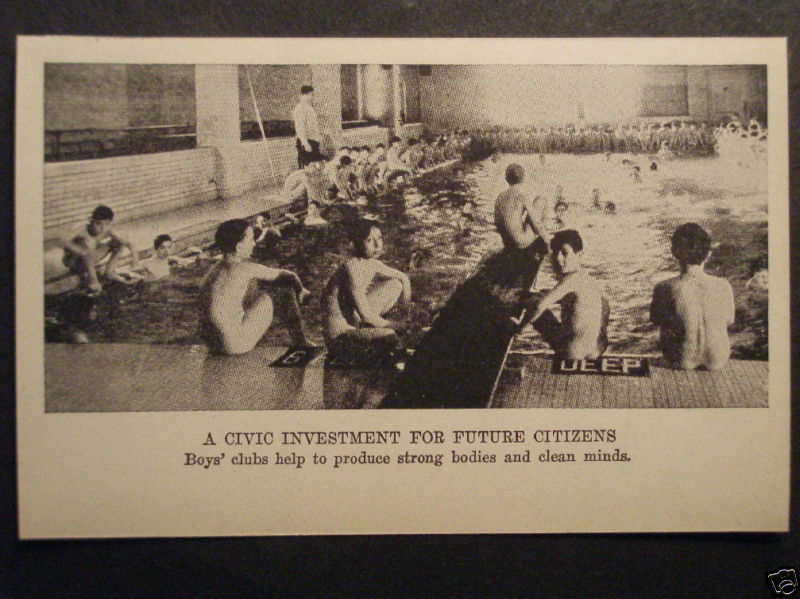
And what would a topic be without an exception? Here is promotional item for the Boys’ Club instead of the YMCA. It is a cropped version of an image that is presented on The Good Too page where the context, purpose and source are mentioned. Here it is in the form of a postcard.
From these numerous examples, the conclusion seems to be that nude recreation at the Y was promoted as a wholesome, healthful, even godly activity. This assertion was apparently endorsed by generations of men.
Topic 6: The Red Gym Pool Liberation
In forums that treat our topic, much is made of the female activism of the late 1960’s through the 70’s and 80’s that broke down the barriers of male exclusivity. Nude male swimming was one of the casualties of that movement. Here is a record of how that came about at the University of Wisconsin – Madison in 1973.
The Red Gym or Armory Pool as shown in the following two images, had a long history of being used for male only nude recreation. The two pictures below preserve views of this long-gone facility.
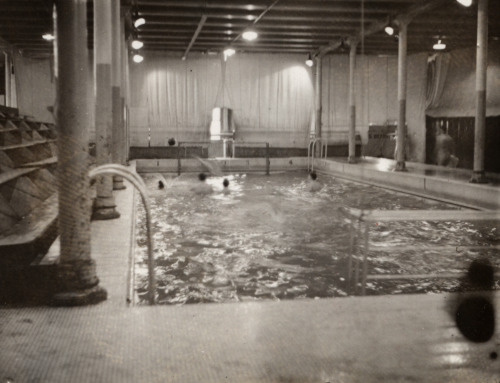
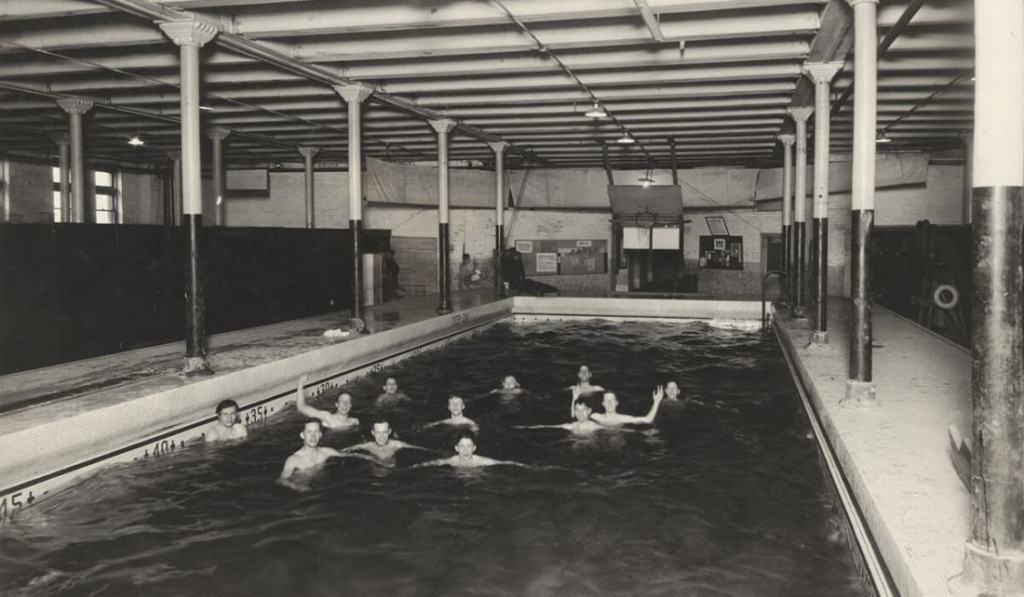
Then, on a Sunday afternoon in February, 1973, some female students invaded this male bastion. The front page of the student newspaper trumpets the event.
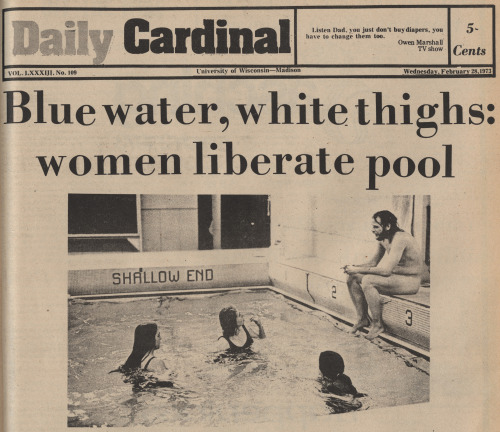
The bold action of the intrepid females is recounted in the paper’s columns as follows:
On an otherwise quiet Sunday afternoon, an attendant at Red Gym placed a frantic phone call to University Police. Several young women had penetrated the interior of the all-male swimming pool and plunged in – naked! The attendant waited impatiently for the police to arrive, by which time the women had re-emerged from the pool and dressed. Despite his initial alarm, the attendant told Cardinal reporter Pat Slattery that “From the way they acted they seemed to be polite and fine girls to me.” The troupe left “quietly” after speaking calmly with the police. But the very same day Slattery reported on this bold (and bare) assault on the pool, the group launched another attack. This time, they donned bathing suits.
“The idea of whether we’re swimming nude or not is irrelevant,” one of the liberators explained. She continued, “We’re prudes if we wear suits and we’re promiscuous women if we don’t. What really matters is the unfairness of the current situation.” The unfairness to which the brazen bather referred was the exclusive male use of the Armory Pool (also known as the Armory Tank). (Although rechristened as The Red Gym, many students still employed its former name.)
Years later what sounded like a minor kerfuffle was raised to the historical status of the Storming of the Bastille – a landmark on the road to female equality. The reinterpretation is given below.
As Kathleen Nichols noted in her 2009 interview with Jason Orne, feminist activists (and one faculty supporter, Ruth Bleier) fought for equal recreational facilities for male and female students. This effort was part-and-parcel with the broader protest movement on campus. Although Lathrop Hall had long housed its own pool, men as well as women swam there, and the facility was often overcrowded. By contrast, male students enjoyed exclusive use of the Armory Pool – and traditionally did so in the nude. Although president Conrad Elvehjem oversaw the construction of an Olympic-sized swimming pool at the Natatorium in the 1960s, “that bathtub in the old red gym” remained a popular swimming hole for undergrad ‘gents, despite plans for eventual demolition.
Curiously, reports on the “liberation” of the Armory Pool in the Cardinal did not refer to Title IX legislation, enacted just months before in June 1972. Title IX prohibited discriminatory or unequal policies on the basis of sex within federally funded educational institutions or programs. Most notably, the ruling mandated equitable investment in women’s athletics, which to that point had received only a small fraction of the spending directed toward men’s sports.
Did the protest succeed, or did it belly flop? The administration at first refused to relent, reasoning that there was no space for women’s locker rooms in the Red Gym. But within the year, the University had allotted funds to making such a space, in addition to providing more equitable facilities across campus. The “liberation” of the Armory Pool proved to be a stroke of genius for feminists on campus.
And everyone lived happily ever after.
Topic 7: Chicken Fight in Michigan Union Pool
In March of 1950 Alfred Eisenstaedt, one of the ace LIFE photographers, visited University of Michigan to do an article on the daily lives of medical students. He photographed them in classes, labs, in study, at home (some were married with children) and at play. In the previously mentioned Michigan Union pool he shot a series of photos capturing some young men (not sure if they were actually medical students or not) capering in chicken fight mode.
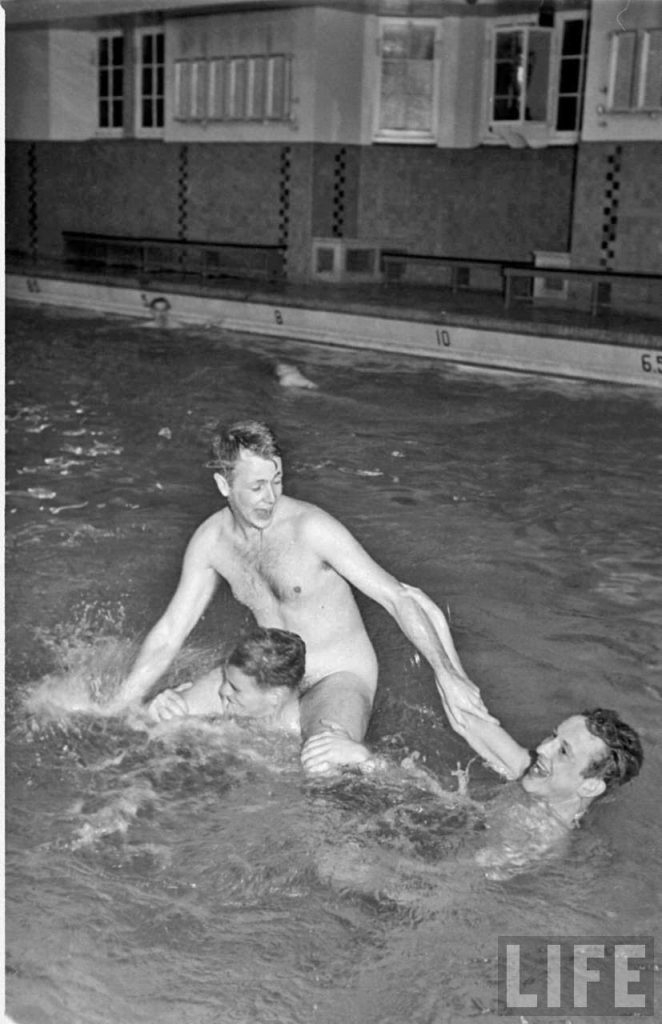
Yes, this is what it appears to be: a naked young man riding on the shoulders of a companion while another colleague playfully tries to unseat him. Note that they are not alone in the pool. What follows is a series of telling images.
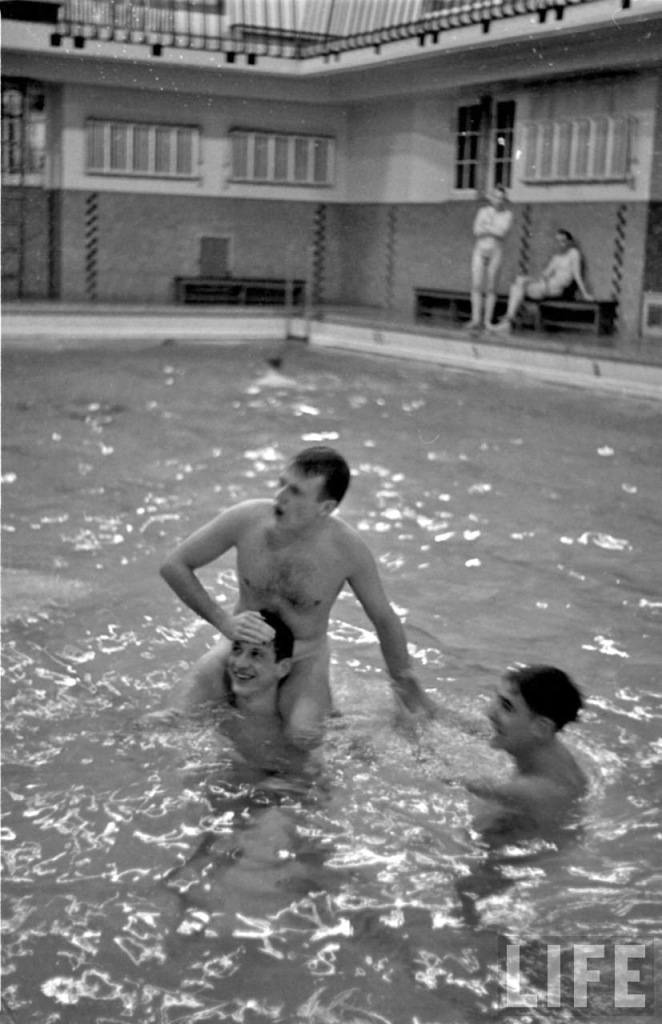
In this image, the background figures begin to tell a story. Two nude men are watching the action from the deck and there is a third in the water (center of the picture) moving away from the camera.
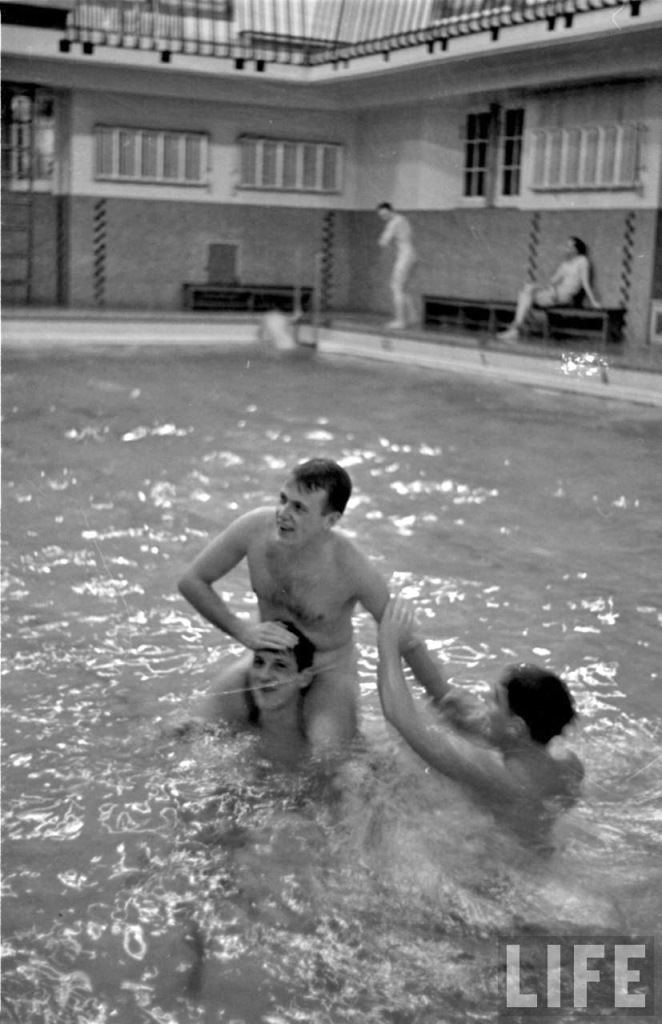
In this slightly marred photo, the person in the water has gained the ladder and is mounting it to leave the pool. The standing figure on the deck has turned to engage with him.
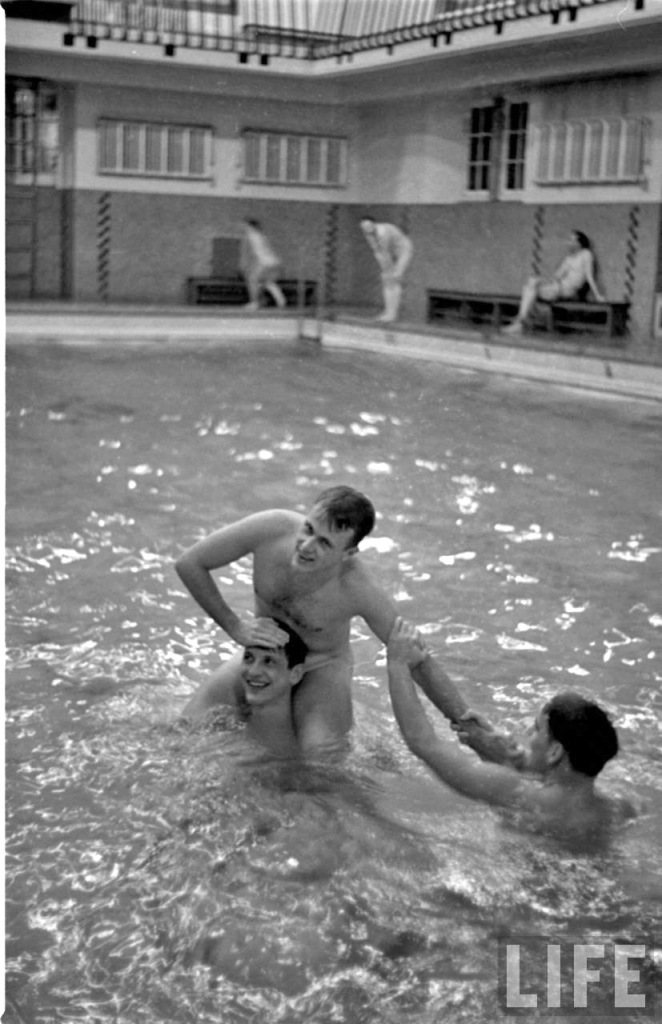
The figure in the pool has now emerged, revealing his nudity as well.
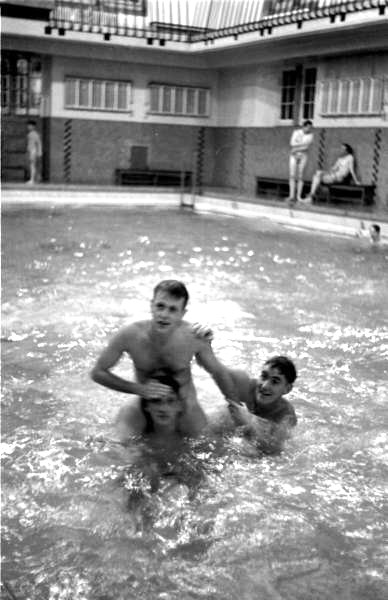
In this last image, the emergent figure turns back to look toward the camera as he leaves the pool area. The standing figure has turned back to favor the viewer with another full frontal as the half chicken fight continues.
The take away message is that this series from a highly reliable source confirms the accounts of aquatic nude recreation being available on college campuses during our period of interest. More to the point, nude men routinely interacted in social or recreational situations without concern and with no sexual overtones. Just a relaxed, normal, guys-being-guys atmosphere.
Topic 8: Canadian Expo Marathon Swim
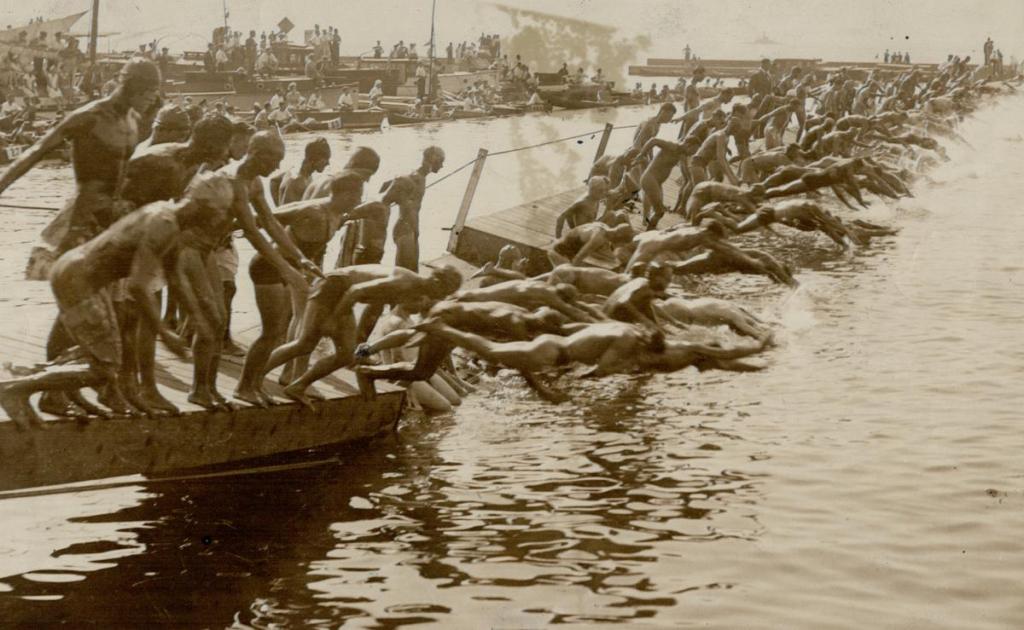
During the second half of August each year the Canadian National Exhibition (The Ex) is held in Toronto. This fair used to include a “marathon” swim competition that took place on Lake Ontario. The length of the course was 10 miles but the interesting aspect was that the temperature of the lake waters in late August still clocked in at a brisk 57F (14C). Hypothermia, anyone?
The reason why we’re considering this event here is that it was clothing optional – both the men’s and women’s contests. Apparently, competitors would report to the starting line covered in some sort of raiment but would peel either as they plunged into the water or as they swam. The 1932 photo above shows the man nearest the camera is diving out of his shorts. If you look further down the line, some divers are already nude. The boats accompanying the swimmers would obligingly retrieve discarded swimwear as the race progressed.
Topic 9: The Great Swim Suit Controversy at Fort Scott, Kansas YMCA 1910
On a happier note, there was a time when the boys stood their ground. See the newspaper article below which relates an attempt by some women’s groups to impose the use of swim suits on the gentlemen at the YMCA. It is interesting to read that in rebuffing the proposal, it was noted that wearing swim suits in the pool was unthinkable. No one does that!
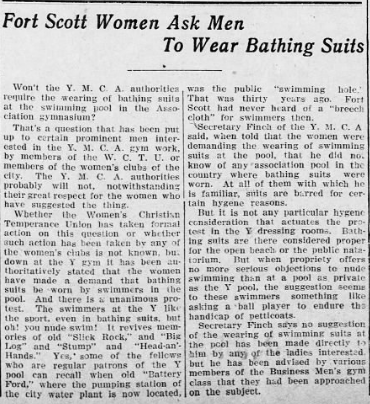
Note that this was before women had the vote.